Great Crew but a Very Battered Dreamliner: My Air India Experience
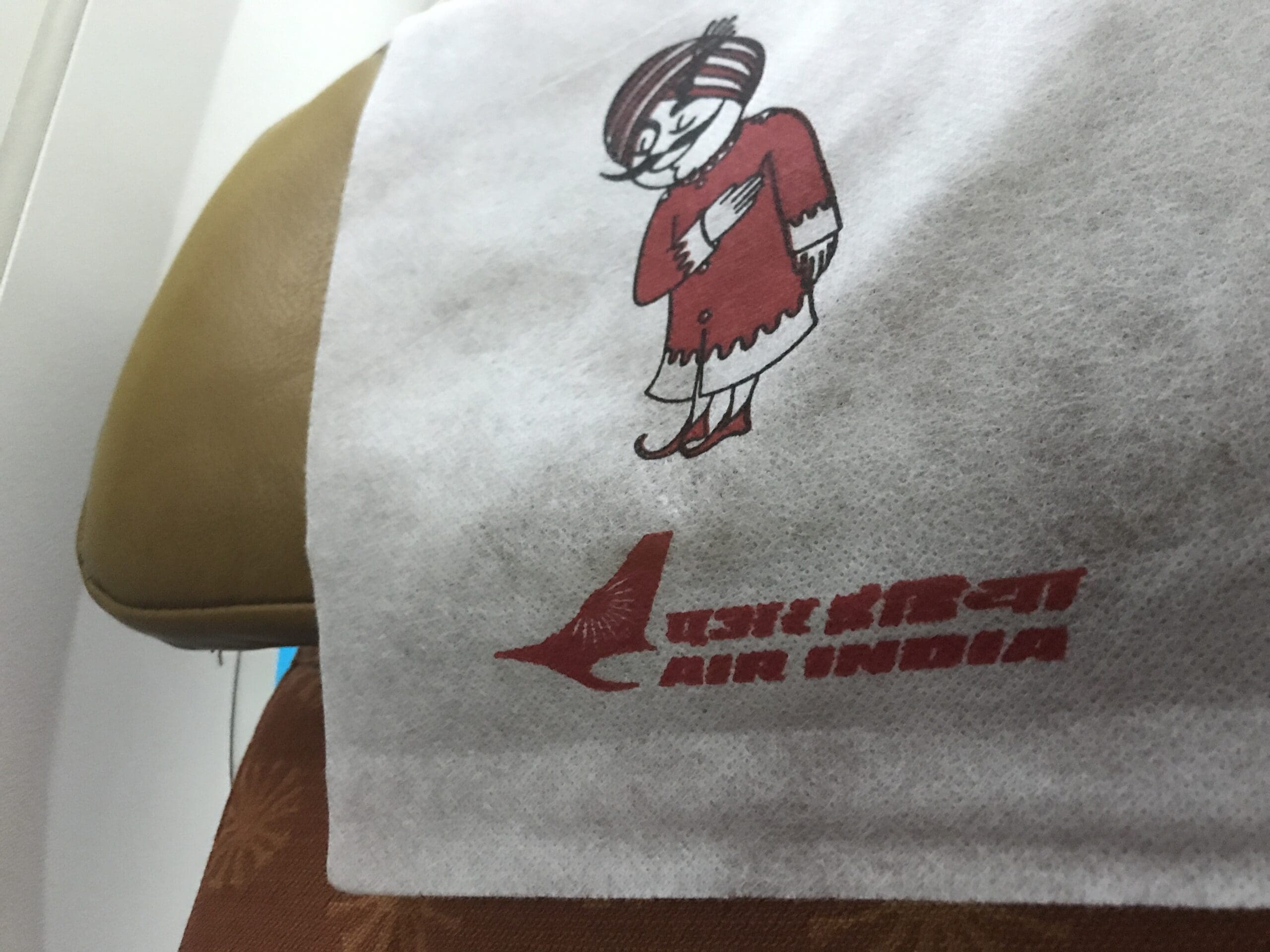
You can skip to the flight by clicking here.
Disclaimer
This flight was taken in July 2017 and I have uploaded this due to moving blog. This was written long before Air India’s Tata takeover. Air India has since halted its fifth freedom route between Hong Kong and Seoul Incheon, flying to both East Asian cities directly from Delhi.
Background
In terms of passenger numbers, the route between Seoul Incheon and Hong Kong has long enjoyed status as one of Korea’s busiest passenger routes. Not only is there an abundance of point-to-point traffic between Korea and Hong Kong, but Asiana Airlines and Korean Air frequently offer reasonably direct one-stop flights between Hong Kong and North America. In the opposite direction, Cathay Pacific’s Hong Kong hub often proves popular for those travelling between Korea and destinations across much of the globe. With everything considered, unsurprisingly direct options are abundant for those wishing to travel between Seoul Incheon and Hong Kong. At the time of my flight in June 2017, this was ploughed by legacy carriers Asiana Airlines, Cathay Pacific, Hong Kong Airlines and Korean Air alongside fifth freedom carriers Air India, Ethiopian Airlines and Thai Airways. Meanwhile, low-cost carriers Air Seoul, Eastar Jet, HK Express, Jeju Air, Jin Air and T’way Air competed against the route’s full service carriers.
Having accumulated 30,000 miles in my Korean Air Skypass account during my time living in Korea, I sought to use these up before I moved back to the UK. This could have taken me on a one-way journey from Korea to Southeast Asia in Economy or enabled me to sample the luxury of a ride in Prestige Class on a flight within Northeast Asia. Whilst I had initially pondered the idea of flying as far as possible using these miles to the likes of Jakarta or Singapore, being slightly limited on time I decided to make a two-day trip to Hong Kong, returning to Korea in Prestige Class onboard a Boeing 777-300ER. Once booked, I turned to search for flights to position myself down to Hong Kong.
In search of a good deal, I hit Skyscanner and as I had expected, the cheapest fares were almost exclusively operated by the route’s low cost carriers. As reasonable as most of my experiences with Korean low cost airlines has been, I hoped for a little more luxury and excitement. As luck would have it, I found that tickets on Air India’s fifth freedom flights were priced at £89, only £9 more than the cheapest tickets on the route. Not forseeing the opportunity to otherwise fly with India’s national carrier any time soon, it didn’t take much convincing for me to select a ticket with Air India over a low cost carrier. Whilst I would have preferred to book directly with the airline, tickets for the service were much cheaper on Go2Gate. Commencing the booking process, I was soon required to slalom through the minefield of optional extras before making payment for my ticket and receiving confirmation by email a few moments later.
Online check-in for Air India’s flights commences 48 hours before departure, however, seeing as I had a one-way ticket to Hong Kong, I was uncertain as to whether I would be able to do this. Fortunately, this worked and I was able to select my seat and receive a mobile boarding pass for my flight with ease.
A Bit About Air India’s Fifth Freedom Route to Hong Kong
Air India commenced service to Korea in July 2005, operating an Airbus A310 four times a week between Mumbai and Incheon with stops in Delhi and Hong Kong. Over time, Air India upgraded the equipment on this service to a Boeing 777 and increased the frequency to a daily flight. At the time of my flight, the airline’s Boeing 787-8 Dreamliners could be found operating this service, with the entire trip between Mumbai and Incheon taking just over thirteen hours. For those travelling all the way between Incheon and Mumbai, Air India’s route adds an additional six hours to the flight’s total journey time compared to Korean Air’s direct Airbus A330 operated service.
The Flight
Being India’s two busiest airports and with limited ramp space and sky, Mumbai Chhatrapati Shivaji Maharaj International Airport and Delhi Indira Gandhi International Airport are not always known for facilitating the most punctual departures. Seeing as the Air India Dreamliner would pass through both hubs, alongside the eternally busy Hong Kong International Airport on its way to Korea, I realised that there were plenty of opportunities for the inbound service to pick up a delay on its multi-stop journey across Asia. Thus, as soon as I woke up on my departure day, I checked FlightRadar24 which revealed that the aircraft had made a punctual departure from Mumbai and was nearing Delhi. However, as it turned out, an unexpected change of aircraft on the ground in Delhi resulted in the flight to Hong Kong departing three hours behind schedule! To Air India’s credit, as the Dreamliner trundled over the Indian state of West Bengal, I received an email from the airline advising me that my flight would depart Incheon two hours behind schedule. Fortunately, with no evening plans in Hong Kong, this was no major issue.
As a cash-strapped university student, when travelling between Seoul and Seoul Incheon Airport, I always opt for the cheapest option, the all-stop Airport Express train. Not only is this the most affordable way of travelling between Seoul and the airport, but passengers can use a T-Money card to ride this service, Korea’s nationwide transportation card. This enables passengers to transfer onto the metro networks of Incheon and Seoul alongside local buses without having to pay another full fare for these. However, that day, I decided to do things a little differently. Seeing as I had spent the morning around Seoul Station, that day I mixed things up a little and opted for the slightly more expensive non-stop AREX service. Completing the 63.8 kilometre journey in 43 minutes, if travelling to or from the service’s terminus at Seoul Station, this is around twenty minutes quicker than the all-stop service. Aside from the quicker journey time, the express services offer a guaranteed comfortable seat (contrasting with the subway style seating of the all-stop trains). Furthermore those with express train tickets and departing from Seoul Incheon on Asiana Airlines, Eastar Jet, Jeju Air, Korean Air and T’way Air can check in for their flights at the City Air Terminal in Seoul Station and use the diplomat/flight crew lane at security and immigration at Incheon Airport. However, of course, this comes at an increased price, with tickets for the express services costing around double the fee for the all-stop train, whilst T-Money cards cannot be used to pay for these.
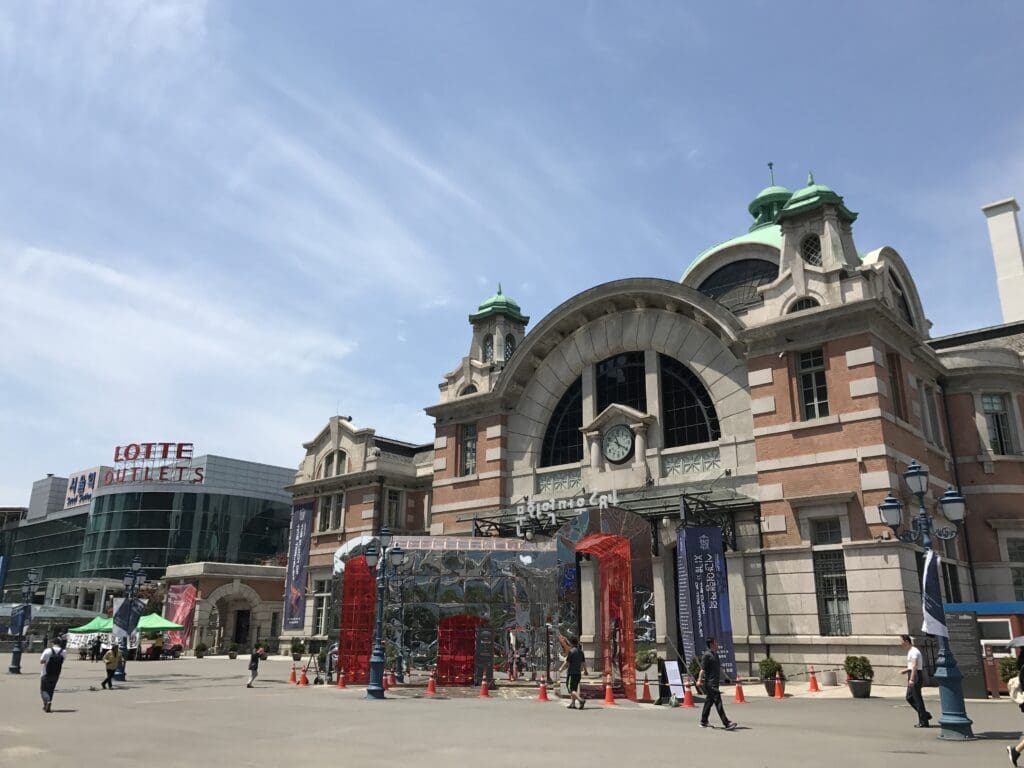
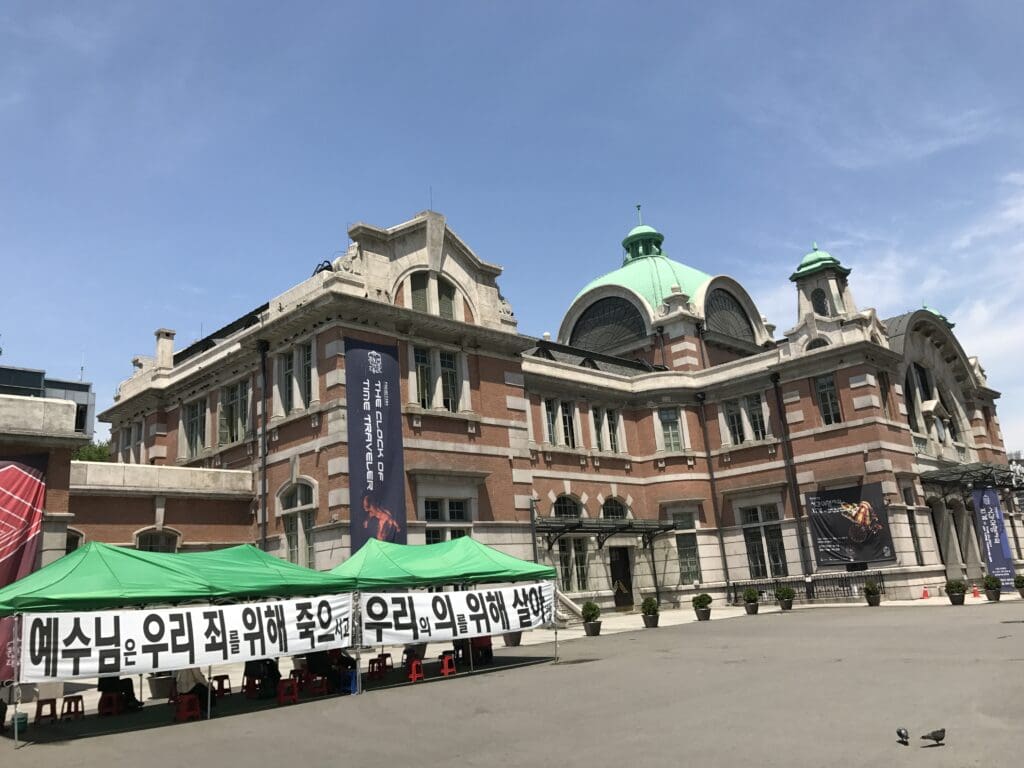
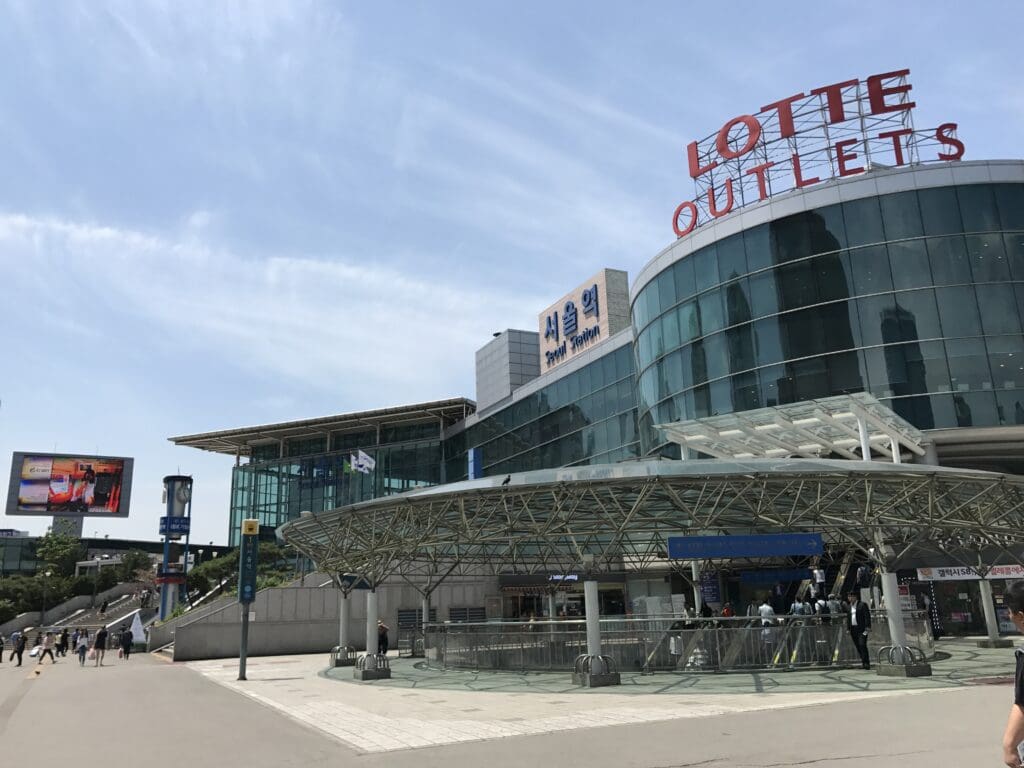
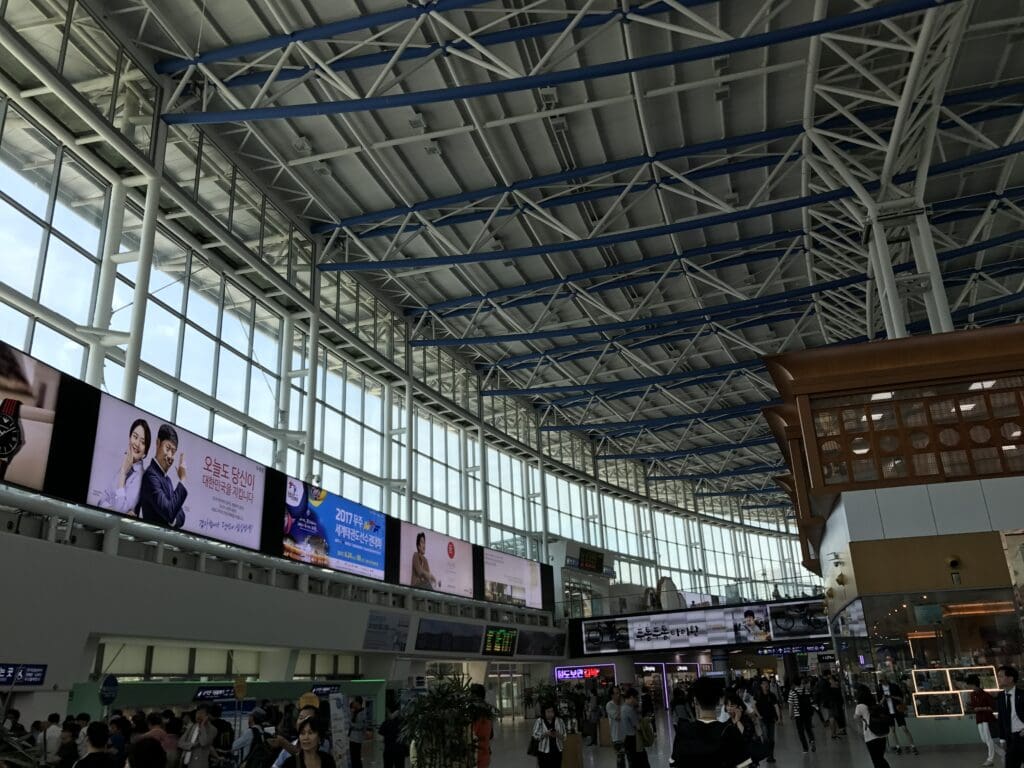
After descending into the depths of Seoul Station, I purchased a ticket for the next departure at one of the self-service machines before passing through the barriers and heading down to the platform. Whilst these run at intervals of around every half hour, having timed things correctly once at the platform the modern Hyundai Rotem train could already be seen waiting to head off. Once onboard, I found this to be comfortable and spotlessly clean, thereby leaving me with no complaints. With relatively few passengers onboard, the doors soon closed and we sped off down the dark tunnels that sit deep under Western Seoul, with the station lights of the likes of Gongdeok, Hongik University and Digital Media City whizzing past every couple of minutes or so. Once we had passed through the latter, we left Seoul behind and headed out into the green space that separates Seoul from Incheon before whizzing over the wide Han River near Seoul Gimpo Airport. Following another short underground dash past Seoul Gimpo Airport, we emerged in the open air once again and passed to the north of the city of Incheon before heading out over the mudflats and waters that separate the Korean mainland from Yeongjeong Island. Before I knew it, my pleasant train ride was coming to an end, and right on time, 43 minutes after leaving Seoul Station, the train came to a gentle halt at Incheon Airport.
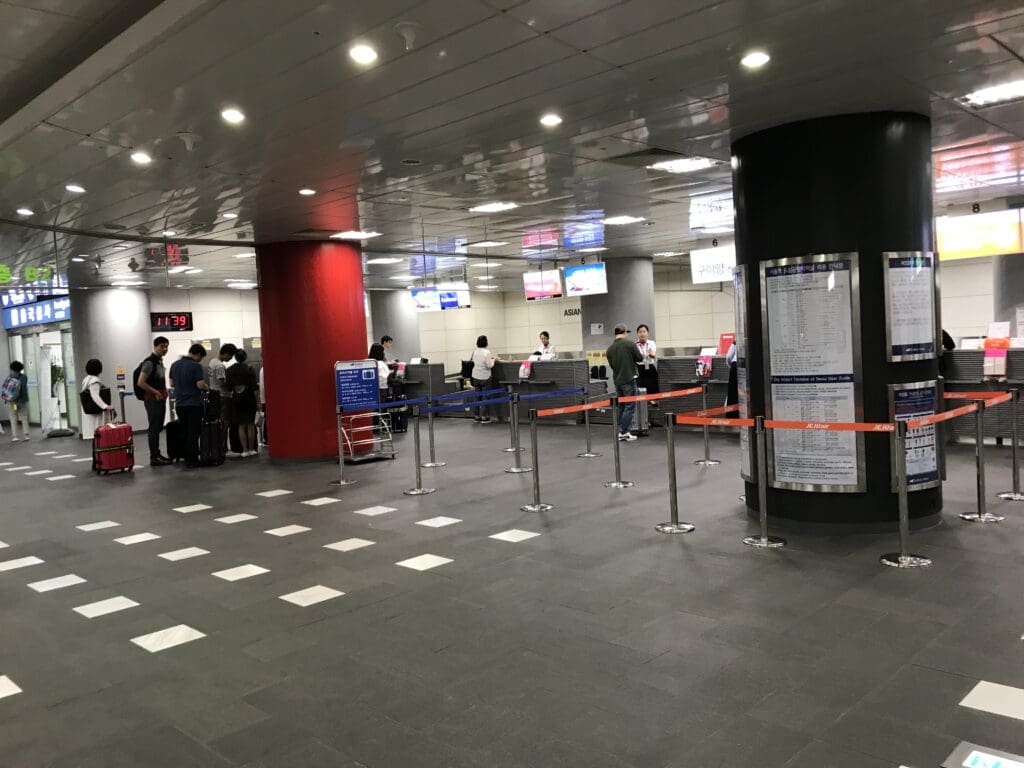
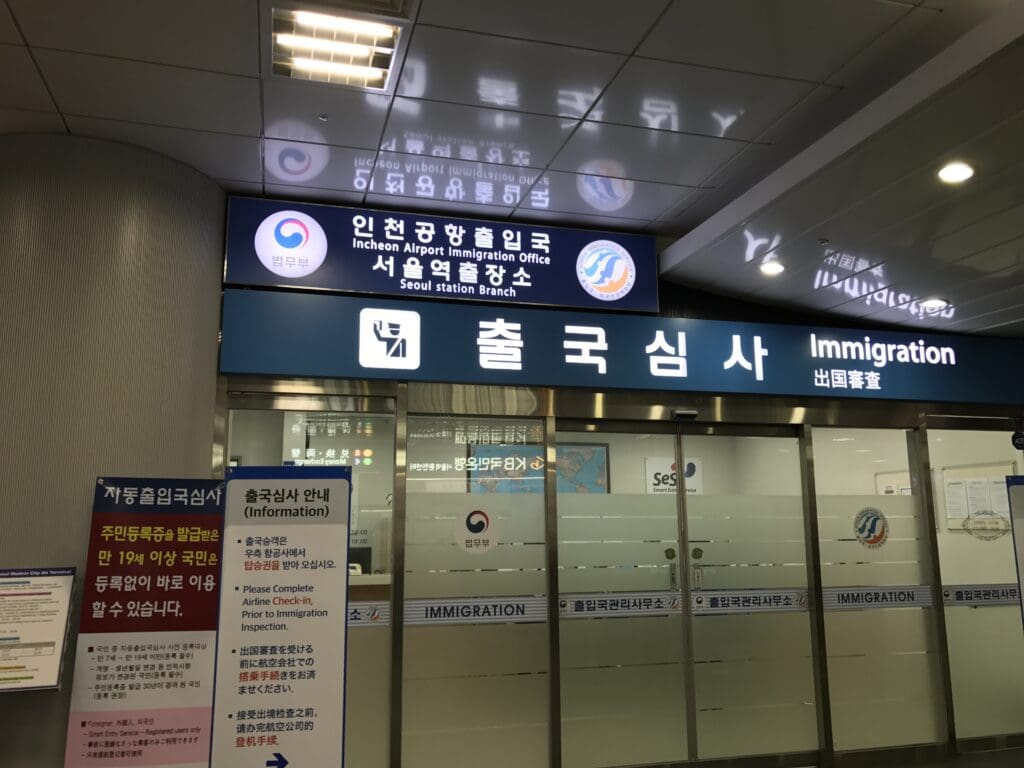
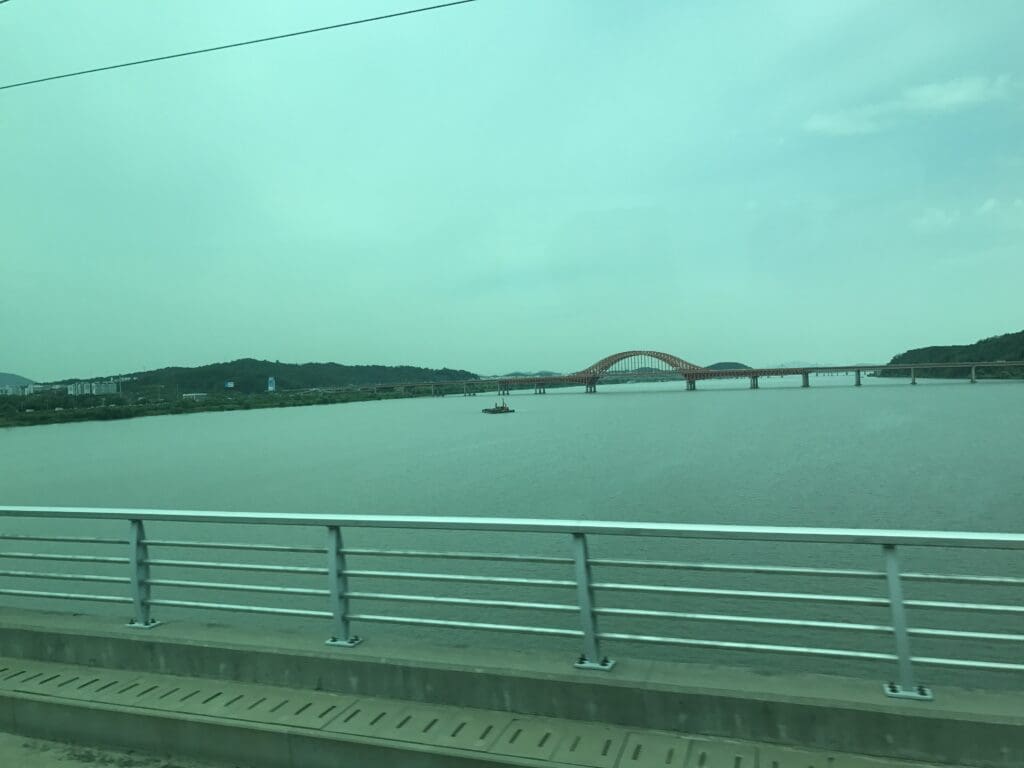
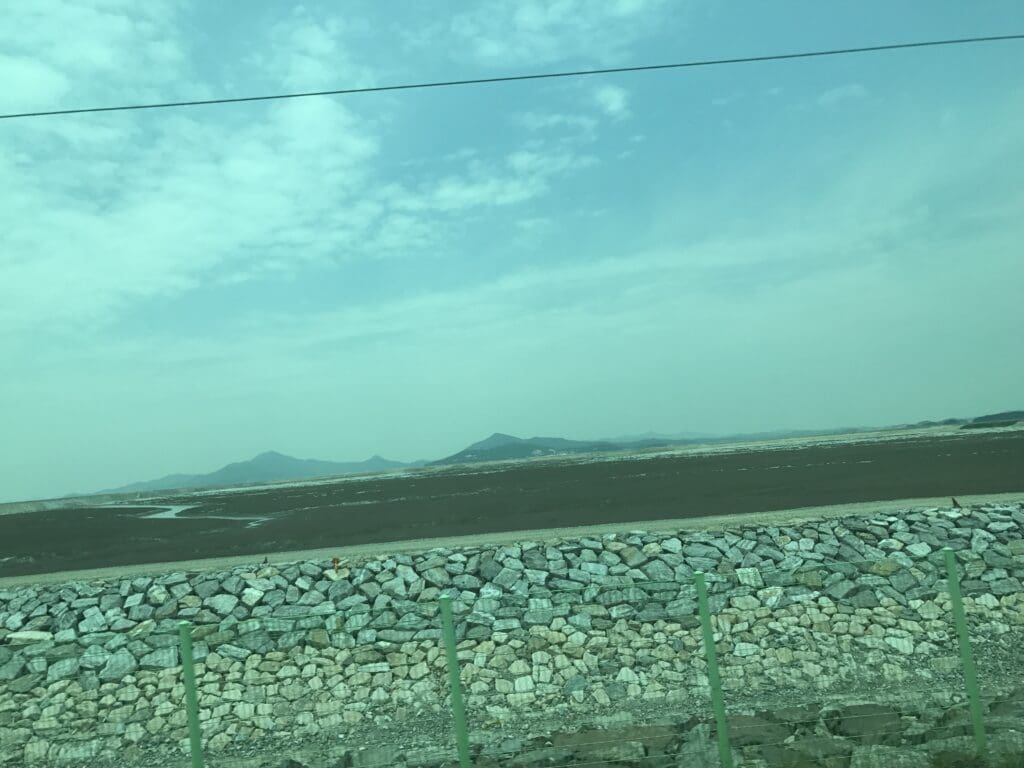
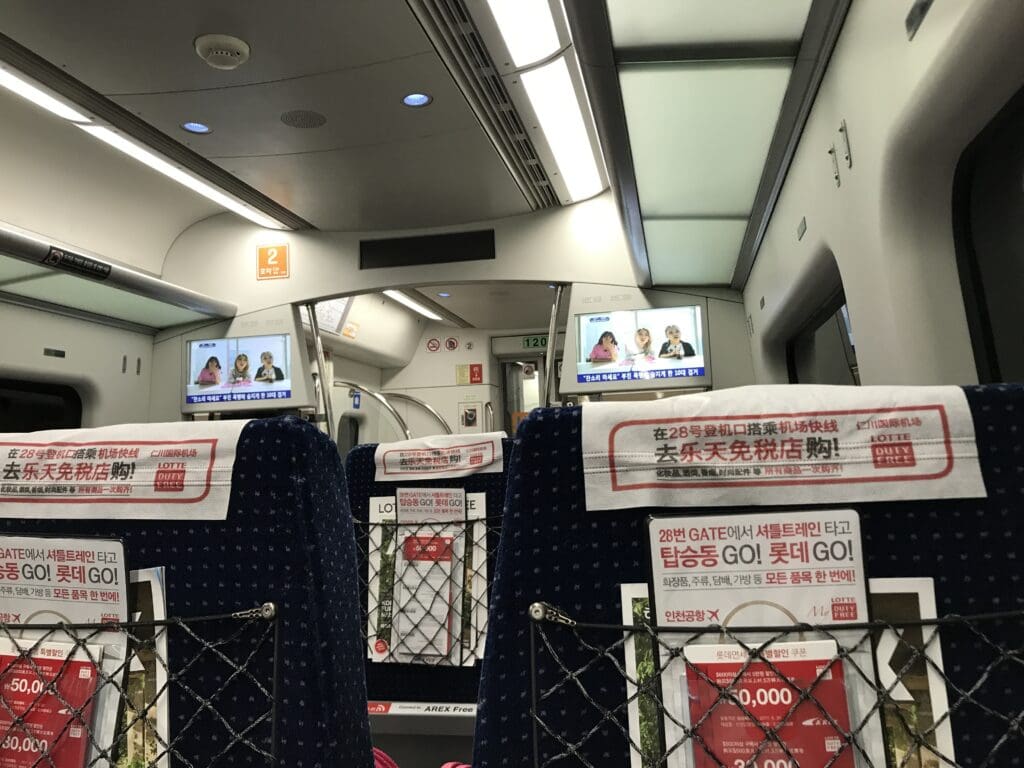
From the platform, I headed up the escalators and found myself in the airport’s ground transportation hub, which is home to several eateries, cafés and a cinema. However, finding the movements outside much more entertaining than the latest blockbuster, I continued onwards to the terminal and after several minutes I arrived at the airport’s large and modern check-in hall. Once there, I headed over to the departure boards which revealed that the delay had neither grown nor shrunk, with the flight still scheduled to depart Incheon two hours behind schedule at 1615 rather than 1415. Whilst I had no bags to check in, I decided to head over to Air India’s check-in desks at Island K in the hope of obtaining a paper boarding pass that I could keep as a souvenir. Upon making it to this island, half the desks there were rather busy, with these assigned to Japanese low-cost carrier Peach’s afternoon services to Okinawa and Osaka Kansai. Fortunately, the neighbouring Air India desks were entirely devoid of passengers and I was able to walk straight up to one of these. Once there, I was greeted by a very friendly Asiana Airport agent who requested my phone number (a common practice when checking in in Korea) before printing off a welcomingly colourful Air India boarding pass. With this process lasting no more than a minute, my initial experience left me with absolutely no complaints and with my boarding pass in hand, I wandered over to the nearest security checkpoint.
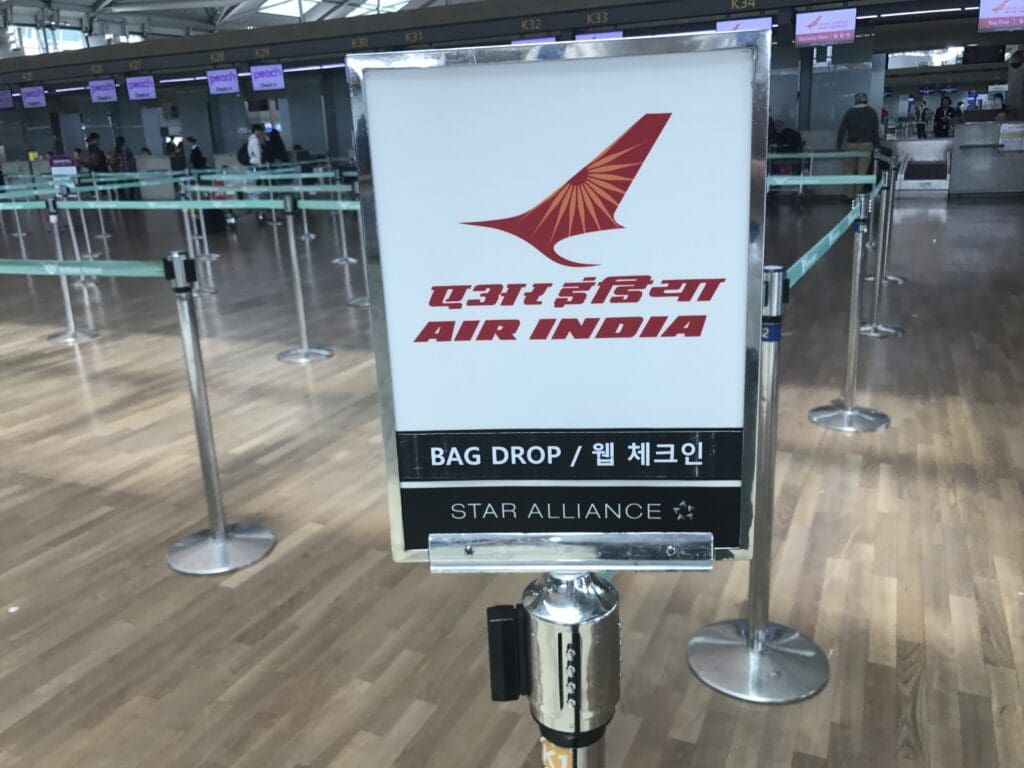
Contrasting with the calm and quiet scenes across much of the check-in hall, to my surprise the security checkpoints appeared busier than I had ever seen them before. Joining the long queue, I ended up standing in line between the gold medal-winning U20 England football team who were on their way home following participation in the U20 World Cup. This lineup included the likes of Fikayo Tomori, Dominic Calvert-Lewin and Ainsley Maitland-Niles who would go on to play for the England adult team and clubs such as AC Milan, Arsenal, Everton and Lyon. Following twenty minutes spent waiting in line behind the jovial players, I reached one of the security checkpoints. As is usually the case, this was thorough yet efficient, and I made it through in no time before reaching a queueless immigration desk. After handing over my Korean identity card and passport, I was given the usual suspicious glances whilst my documents were scanned before I made it to the airside portion of the terminal.
That afternoon, unsurprisingly the airside portion of the terminal was rather busy, although as is usually the case, this was clean and tidy, and plenty of seats were available for those passengers needing to rest their legs. Still having plenty of time on my hands before departure, I decided to wander around the main terminal where I admired the masses of Asiana Airlines and Korean Air jets waiting to head off to destinations across the world. Following a long stroll up and down the piers, with my flight departing from the satellite terminal, I made my way down the escalators and soon arrived at the automated people mover station.
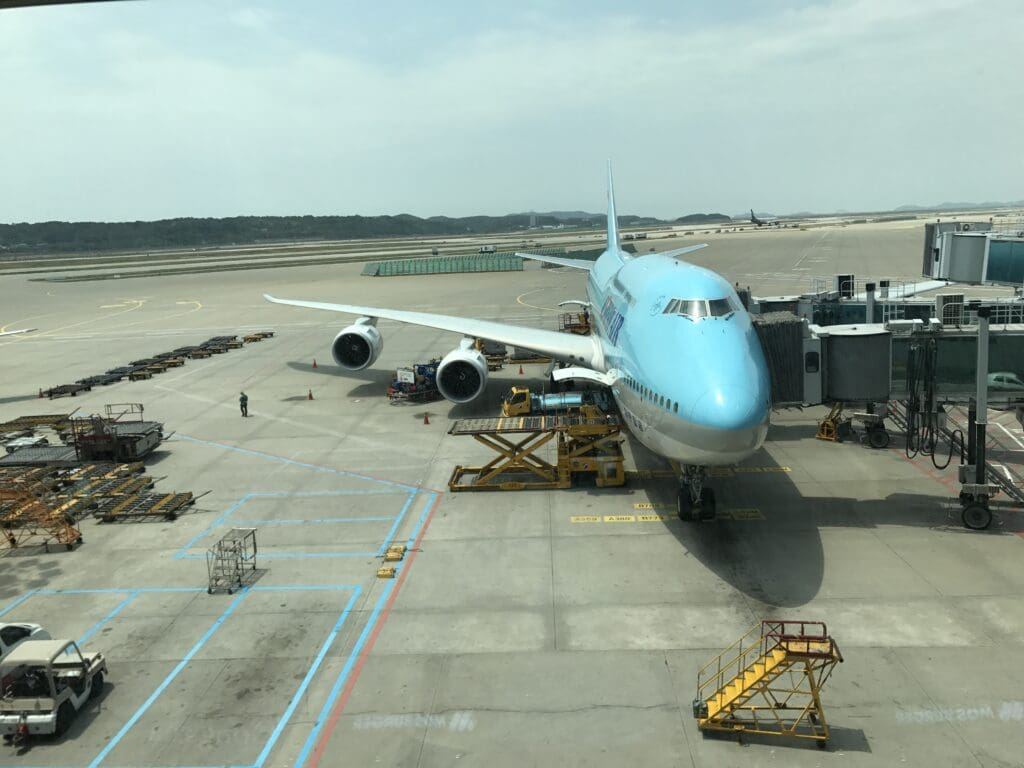
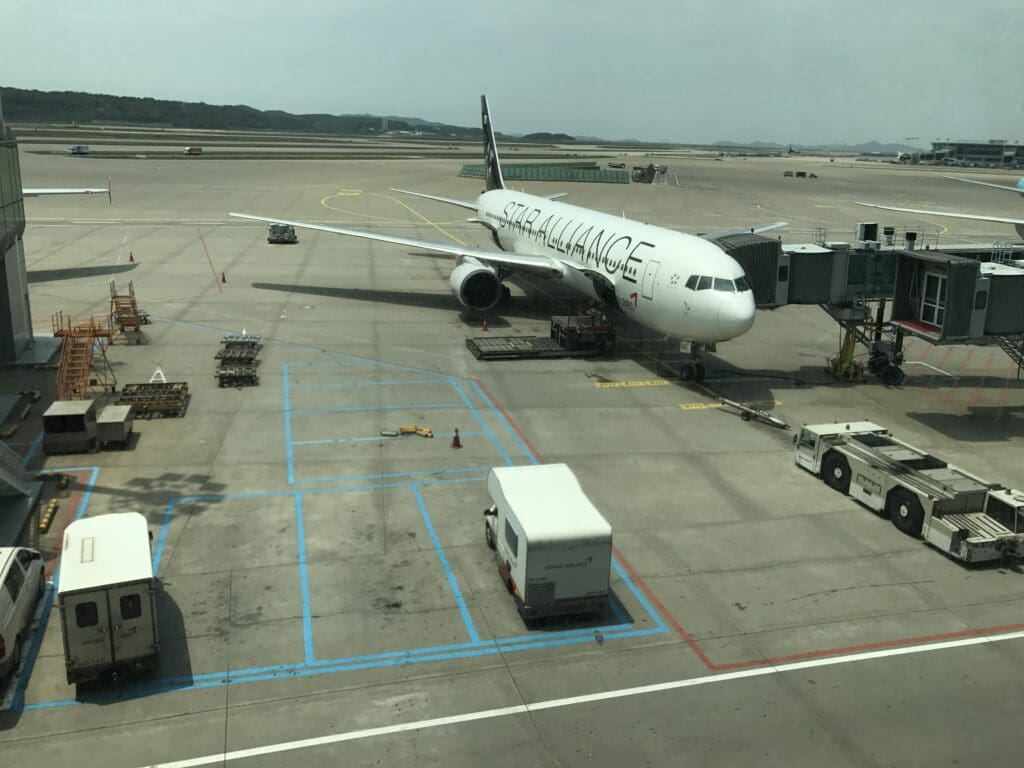
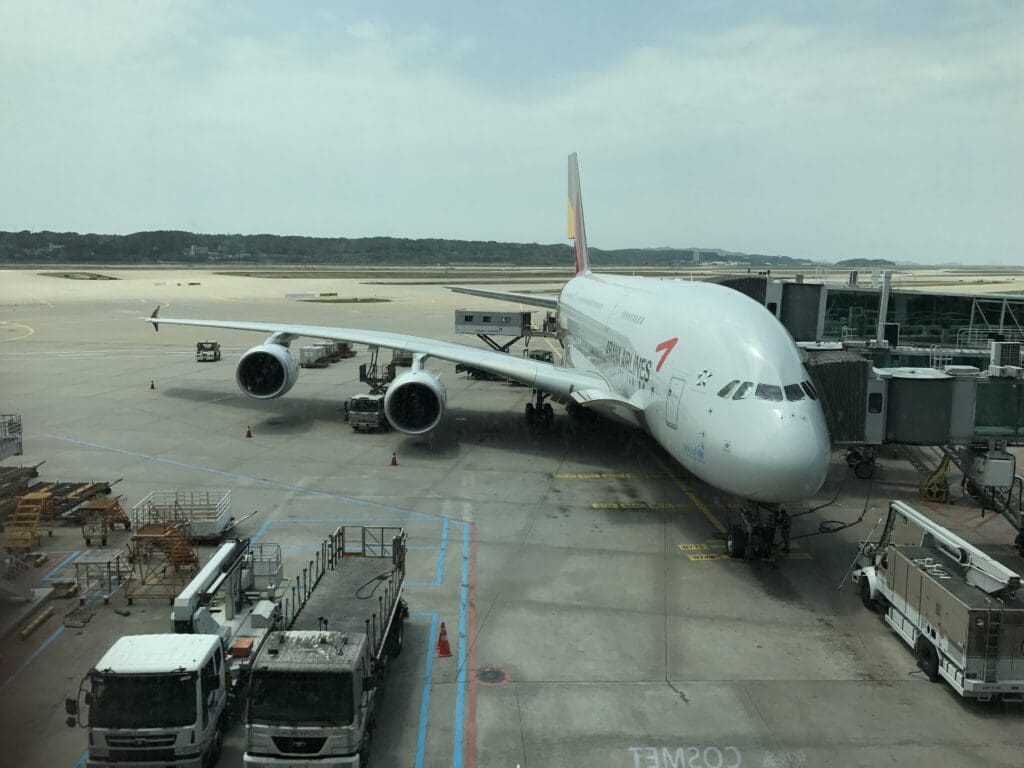
Once there, I decided to wander over to Gate 113 from where the Air India service to Mumbai via Hong Kong and Delhi was scheduled to depart. Arriving there at about 1500, at that time few passengers could be seen, thereby indicating that the flight would either be near-empty, or those heading off on this were busy exploring the terminal. Taking a seat there, I plugged my phone into one of the plug sockets to charge and much to my delight, within a few minutes of sitting down a trolley appeared stacked with a mountain of small cardboard boxes for those heading off on the delayed Air India service. These contained two small sandwiches – one containing tuna and the other ham and cheese, a small tub of water, a Twix, crackers and a single Laughing Cow cheese triangle. Being far better than the near non-existent offering that I had been treated to with my recent delays in China, this left me with no complaints.
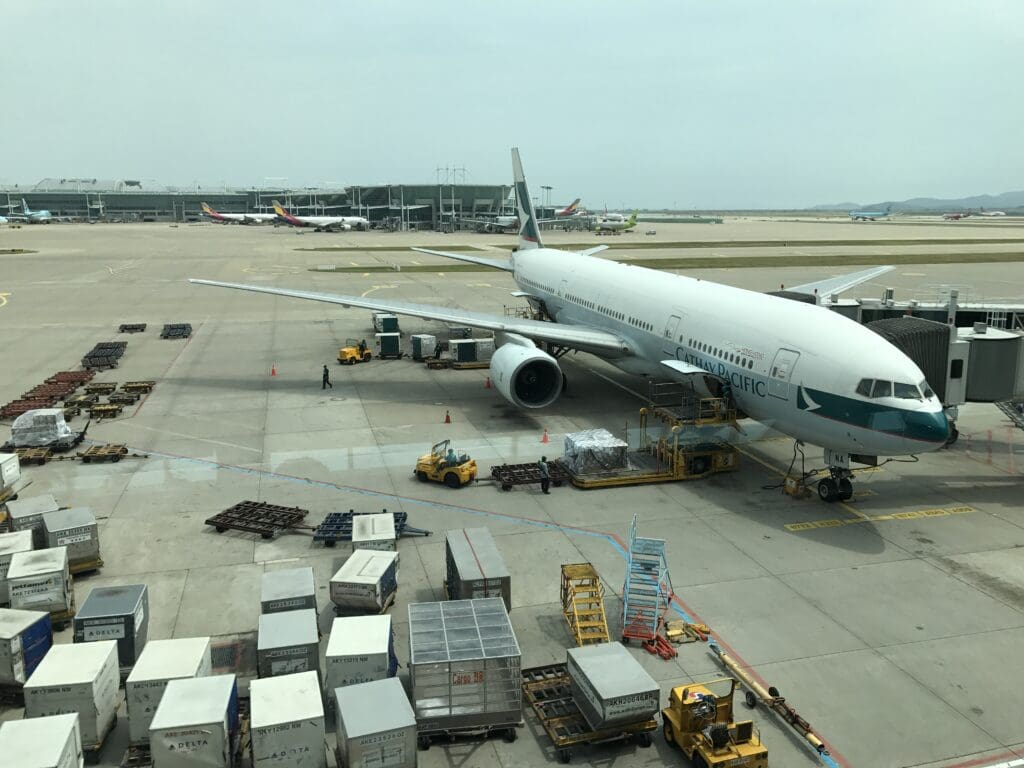
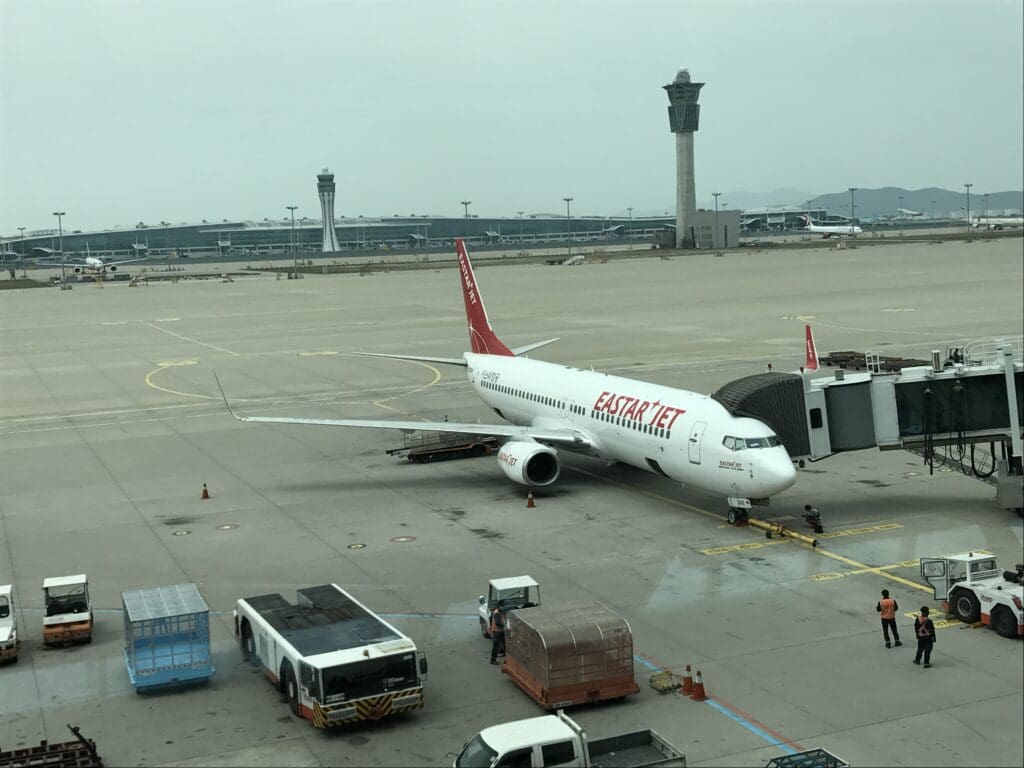
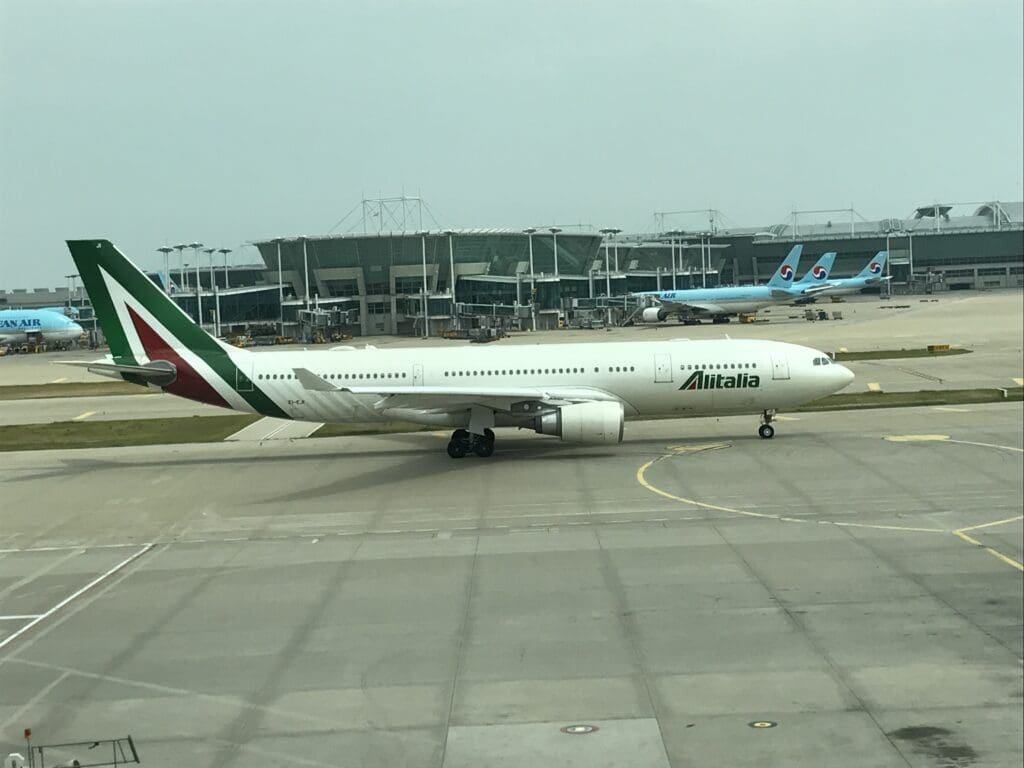
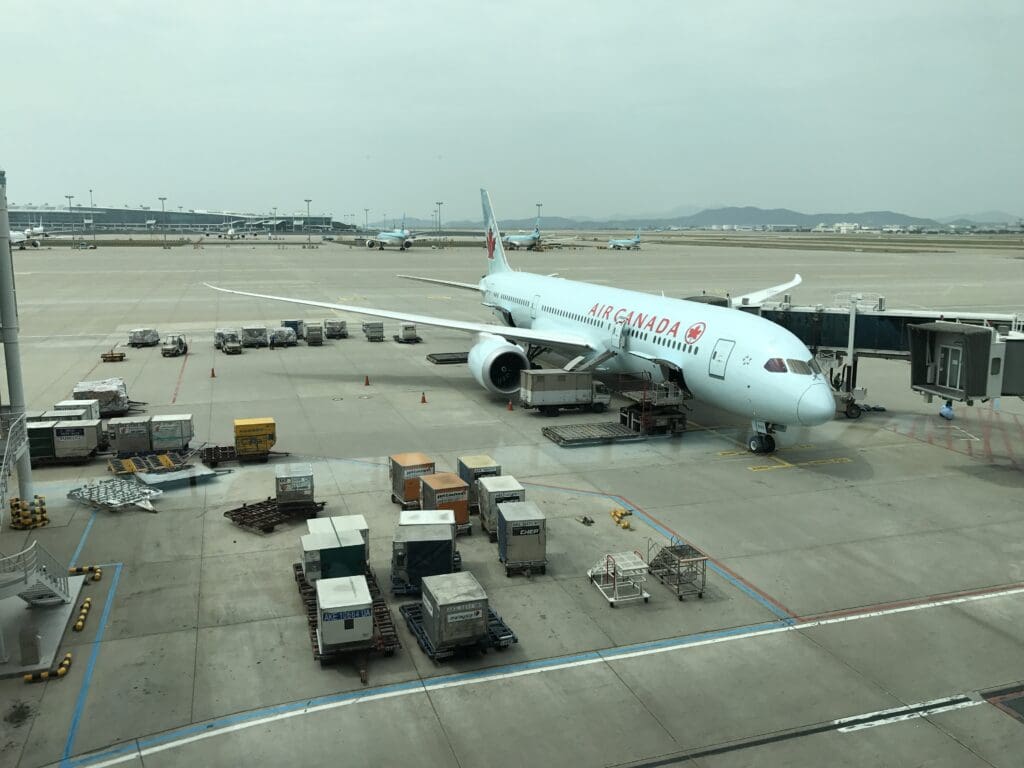

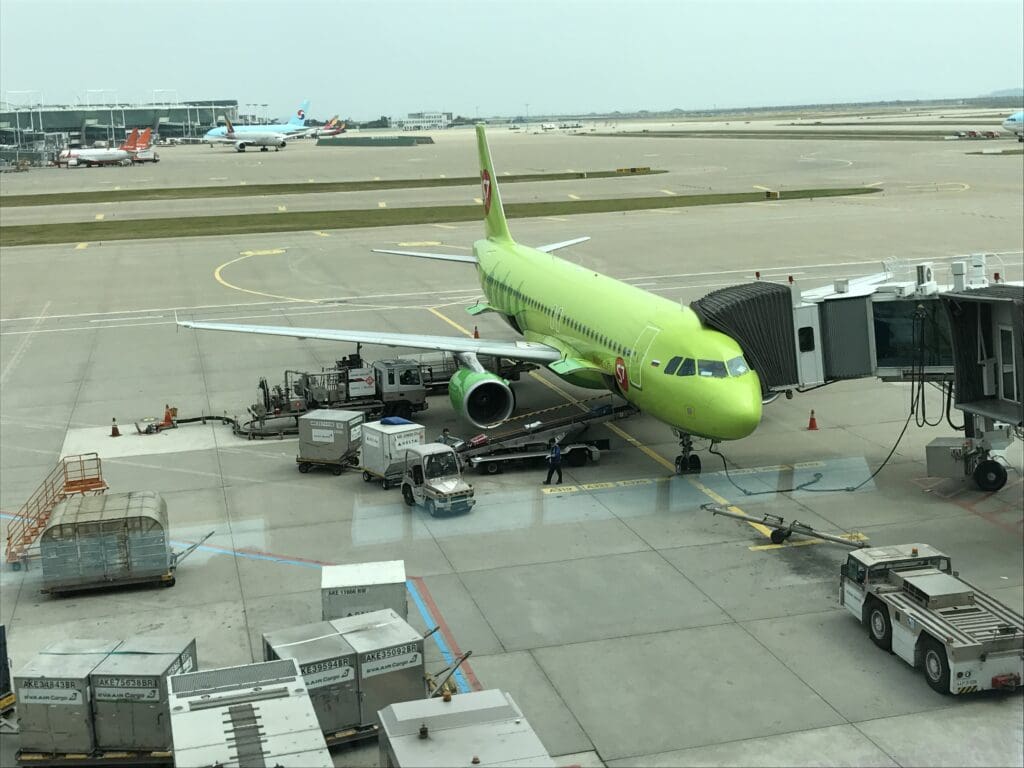
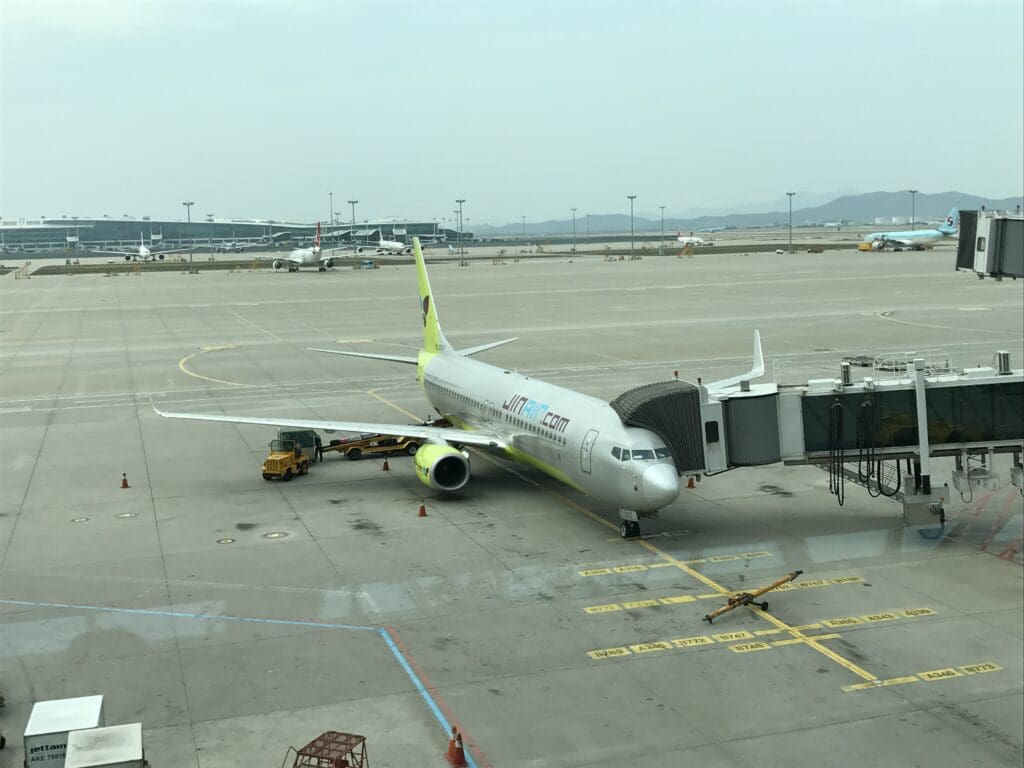
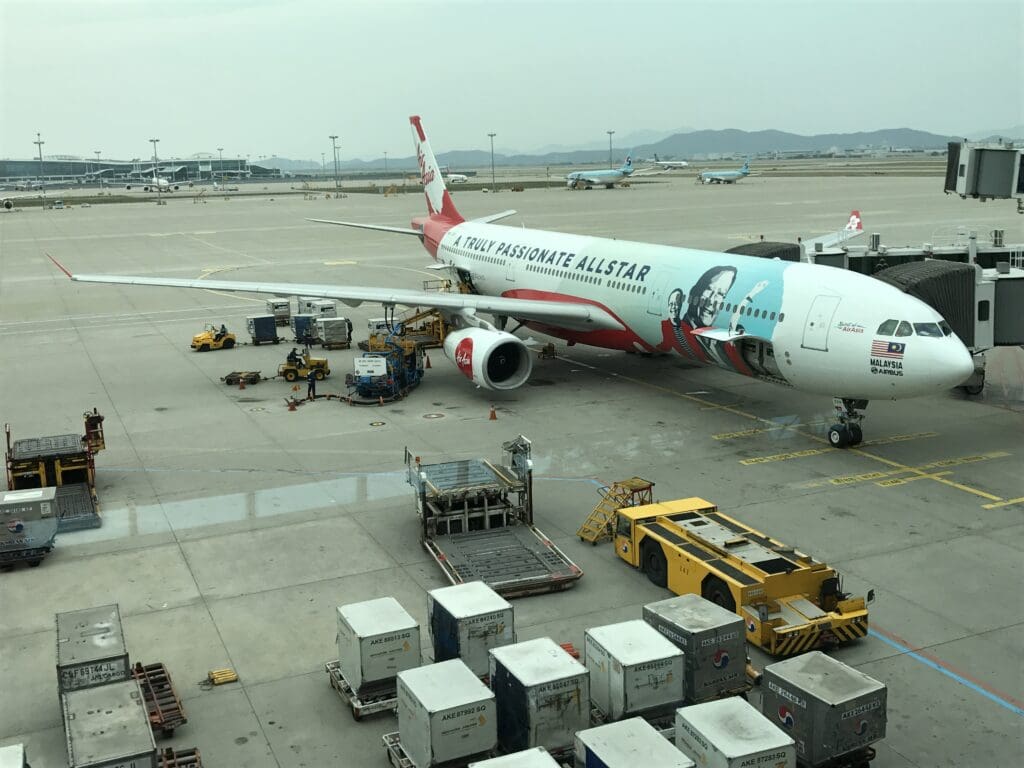
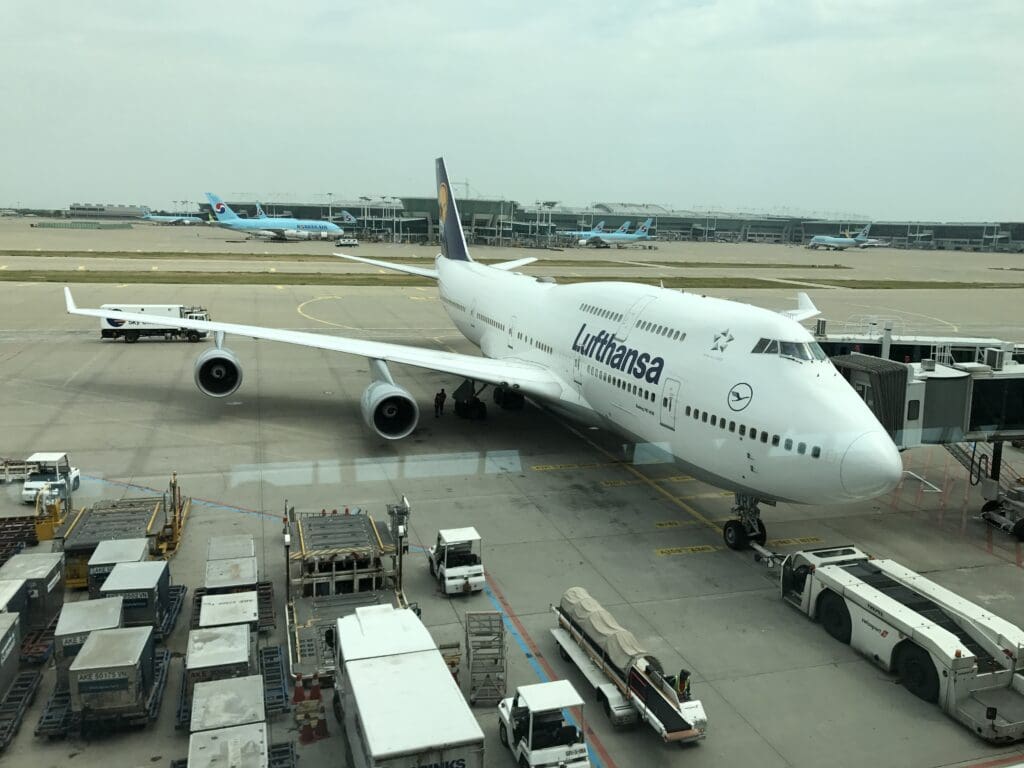
With thirty minutes to go until the delayed flight’s new scheduled boarding time, there was no sign of the aircraft outside, thereby indicating that we would be subject to a further delay. In fact, rather than an Air India Dreamliner, the Queen of the Skies, a KLM Boeing 747-400 Combi could be seen coming to a halt outside. Whilst I had initially believed this would mean that our gate would be changed, once passengers had disembarked and their luggage unloaded, the aircraft was pushed back from the terminal and pulled to a remote stand where it would rest until making the long journey back to Amsterdam.
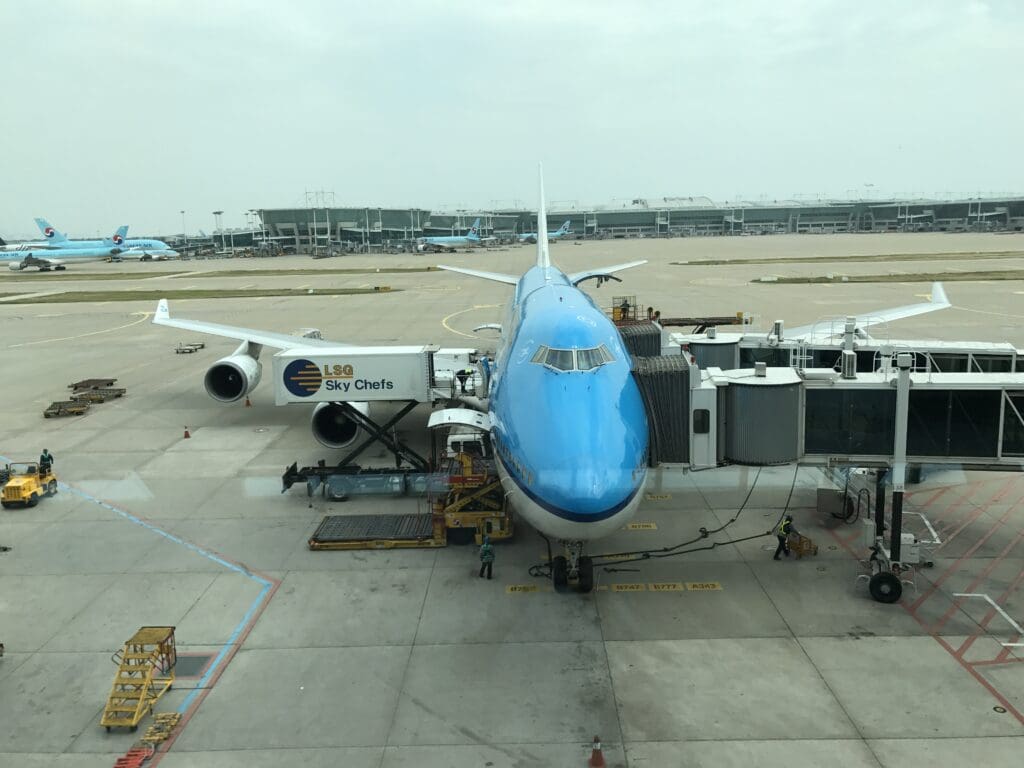
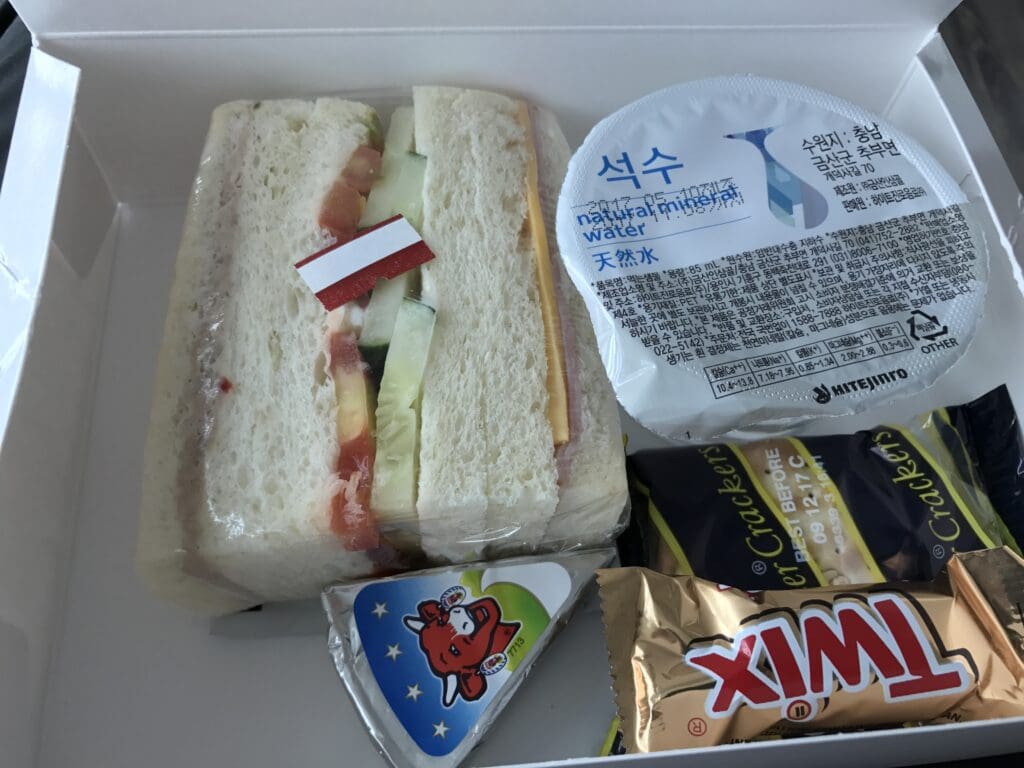
Eventually, at 1545, I caught sight of the slightly weathered-looking Air India Boeing 787-8 Dreamliner as it touched down on Korean soil after its long and delayed trek. A few minutes later, this pulled into Stand 113 where a team of Asiana Airport workers sprung into action, opening the hold doors and connecting the jetbridge. Inside the terminal, at this time, one of the gate agents performed an announcement in Korean and English apologising for the boarding delay. Looking at the glass jetbridge, disembarkation seemed to take almost no time at all, with the flight from Hong Kong appearing to be near empty, although a seemingly never ending stream of cargo could be seen being unloaded from the holds. Meanwhile, despite several ground crew members shuttling to and from the aircraft, other than the Captain who emerged from the aircraft to undertake their pre-flight walkaround, the crew remained firmly onboard indicating that they had undertaken their layover in Hong Kong.
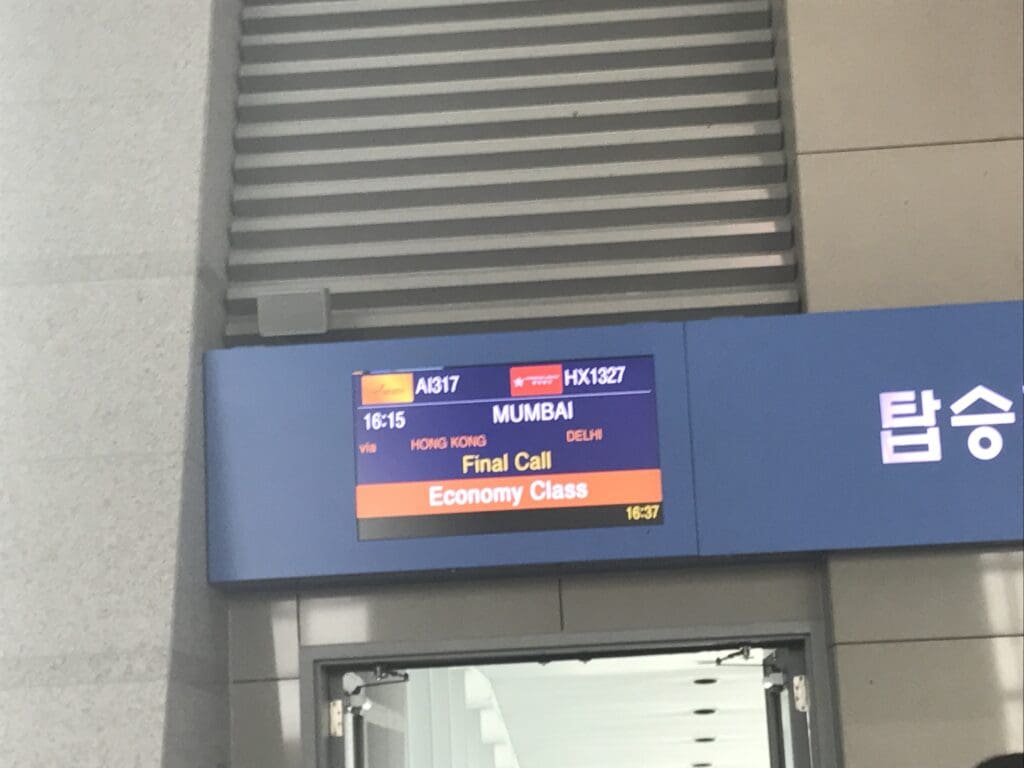
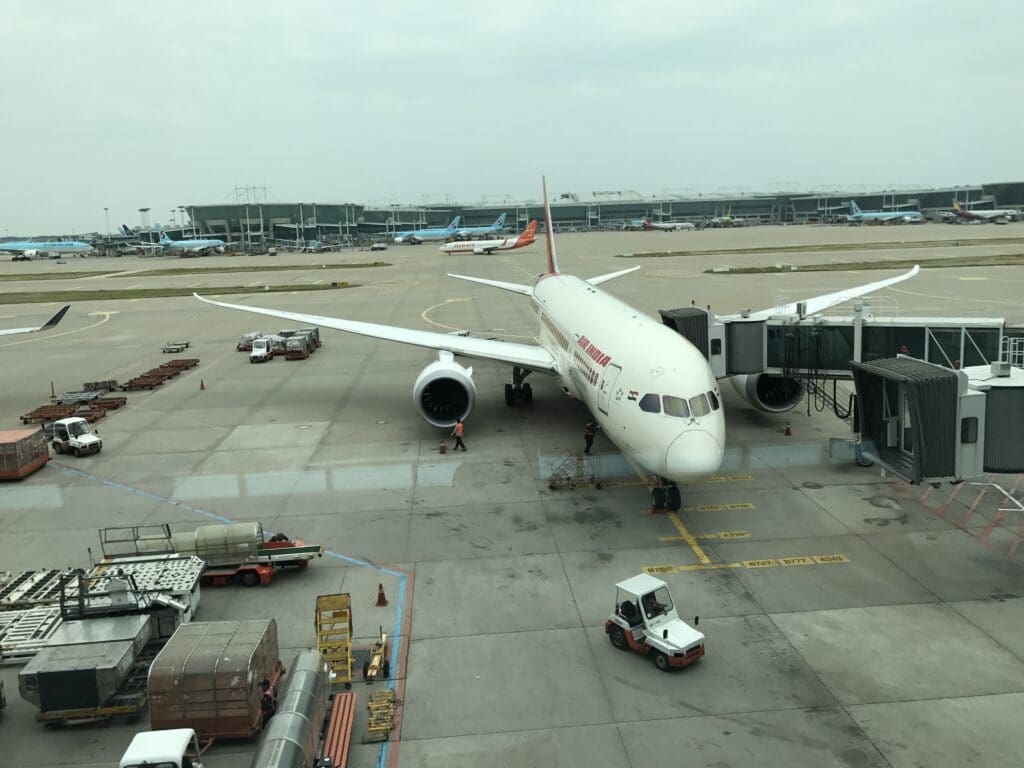
That day, I would have the pleasure of flying onboard one of the oldest Dreamliners, VT-ANG. Carrying line number 32, this aircraft was assembled in Everett in early 2011, although like many of Air India’s Dreamliners, the aircraft would end up in long-term storage outside the Boeing factory. Eventually, in 2013 the aircraft’s two General Electric GEnx engines were attached and in October of that year, the jet made its first test flight, before being delivered to Air India the following month. Since then, the aircraft has been dispatched on routes between India and destinations across Asia, Australasia and Europe, with most flights going without a glitch. However, in September 2015 a low oil pressure indication forced the crew to shut down an engine as it neared Singapore on a flight from Chennai. Highlighting the diversity of destinations visited by Air India Dreamliners, in the week before my flight, VT-ANG had travelling at least 51,000 miles and visited Amritsar, Cochin, Dubai, Hong Kong, Incheon, Kolkata, London Heathrow, Milan Malpensa, New Delhi, Rome Fiumicino and Vienna.
A grand total of fifteen minutes after the flight’s new scheduled departure time, at 1630 one of the gate agents made an announcement inviting those requiring assistance and Business Class passengers to board the aircraft. A few minutes later, all Economy passengers were invited to board the jet at which point I joined the short queue before I had my boarding pass scanned and torn and my passport checked. From there, I journeyed down the escalators and wandered down the glass jetbridge to the waiting Dreamliner. However, with just one jetbridge attached to the aircraft and with passengers taking their time to board, I soon hit a queue and ended up waiting for a few minutes before making it to the L2 door.
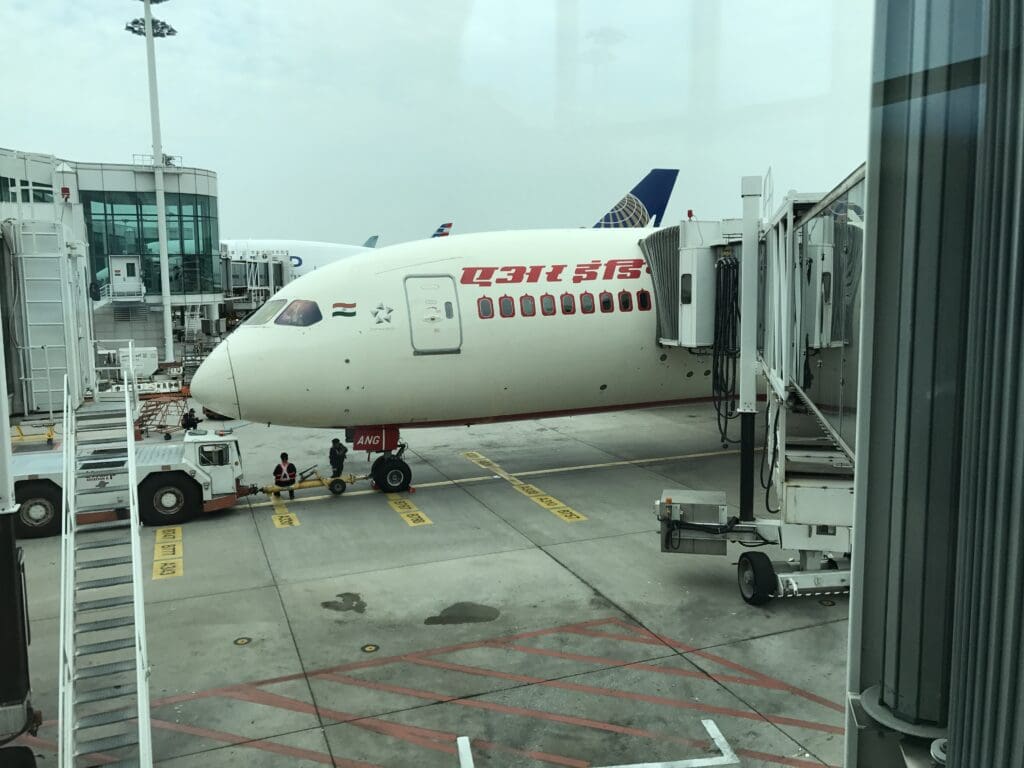
Creating a good first impression of the crew, as soon as I entered the galley that separates the Business cabin from the forward Economy section I received a friendly ‘namaste’ from the two crew members standing there before I turned right down the second aisle and began the journey to my seat, Seat 32J. Onboard, like most Dreamliners, seats were arranged in a nine-abreast 3-3-3 layout, and each seat was covered in a vibrant and distinctive red or orange fabric that featured a repeating pattern, with this visual warmth further assisted by the deep red carpet. Each of the 238 seats in Economy was topped by a pleather-covered adjustable headrest, with these partially covered by a disposable antimacassar that sported Air India’s logo and famous Maharaja. Meanwhile, both blankets and pillows could be found on every seat, and whilst these were not of particularly memorable quality, they were appreciated given the short length of the flight (even though I am sure that these would have been expected by those heading all the way to India).
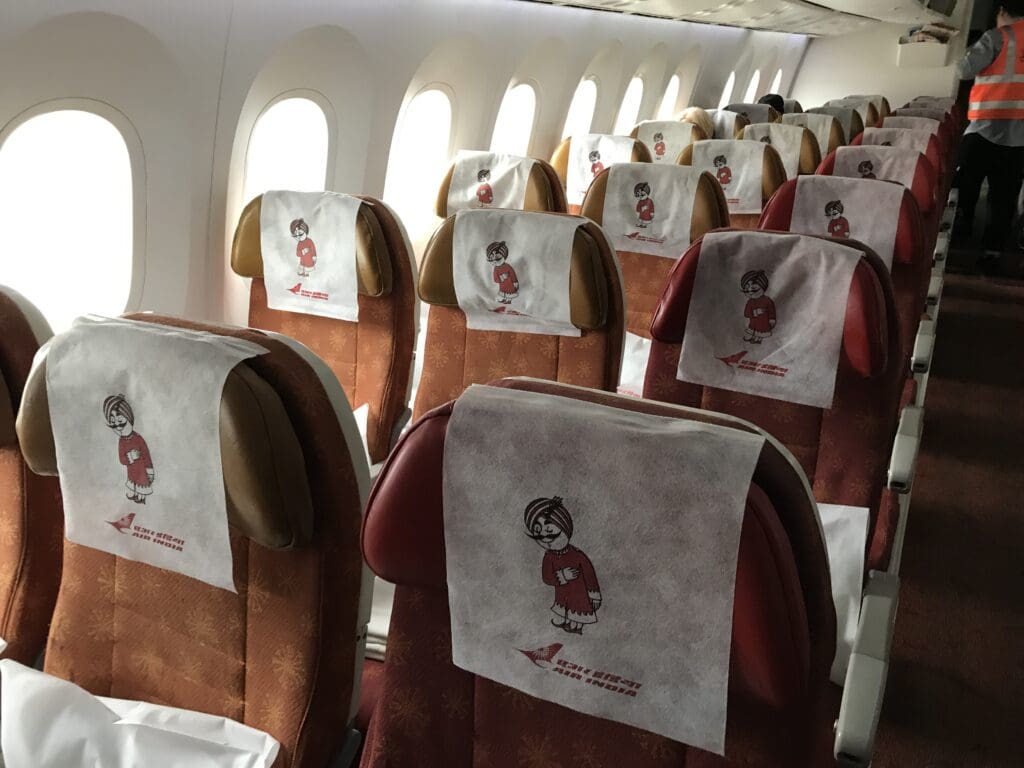
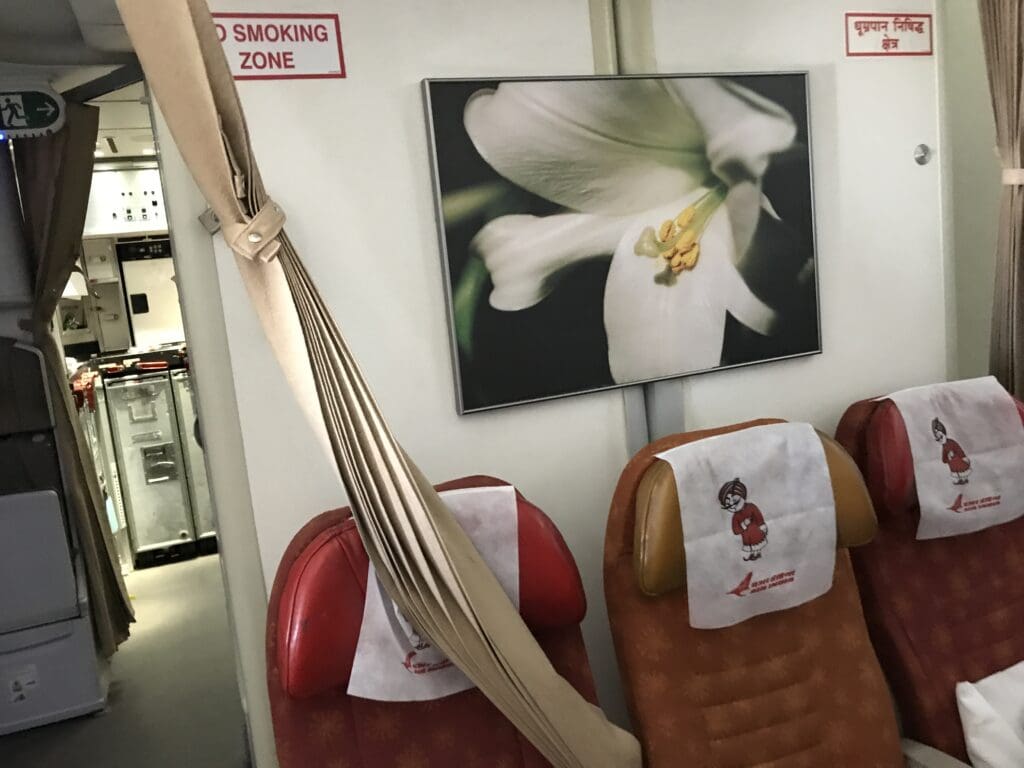
As I made my way down the aircraft I continued to receive greetings from the polite and friendly cabin crew, and once in the rear Economy cabin, I spotted a Sharps Aviation K engineer sprawled out on the floor at the rear of the cabin, undertaking some last minute (and hopefully non-crucial!) repairs to the aircraft. Once at my row, I couldn’t help but notice that seats 32G, H and J had been mislabelled as 32D, E and F – something that would undoubtedly have the potential to cause some confusion amongst passengers! However, confident that I would be travelling to Hong Kong in the window seat, I soon slid into this and settled in for the ride southwards.
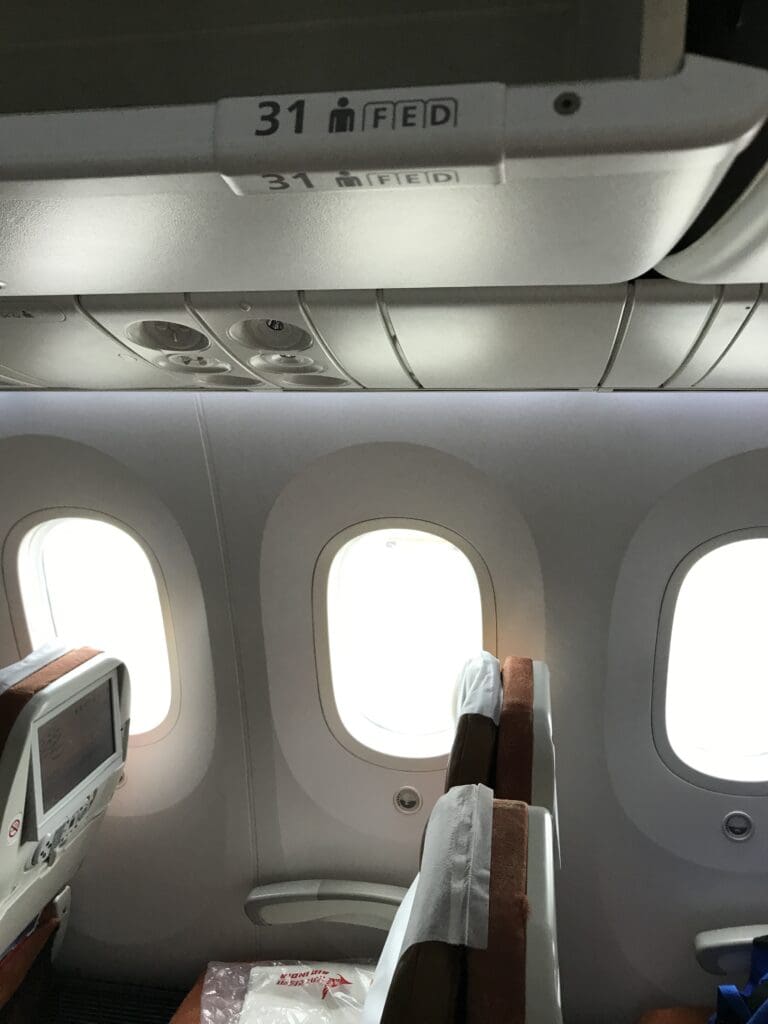
Once seated, I have to admit that I was taken aback by the battered state of my seat and the area around this. Despite being a reasonably new jet, the aircraft had one of the most tired-looking cabins I have encountered in quite some time, featuring peeling stickers, worn buttons or bits of plastic hanging off here, there and everywhere. This hinted that Air India had neglected to undertake any non-essential maintenance in the cabin. On the plus side, the army of cleaners appeared to have done a good job cleaning the aircraft during its short stay on the ground in Korea and I failed to spot so much as a single stray crumb as I inspected the area around my seat.

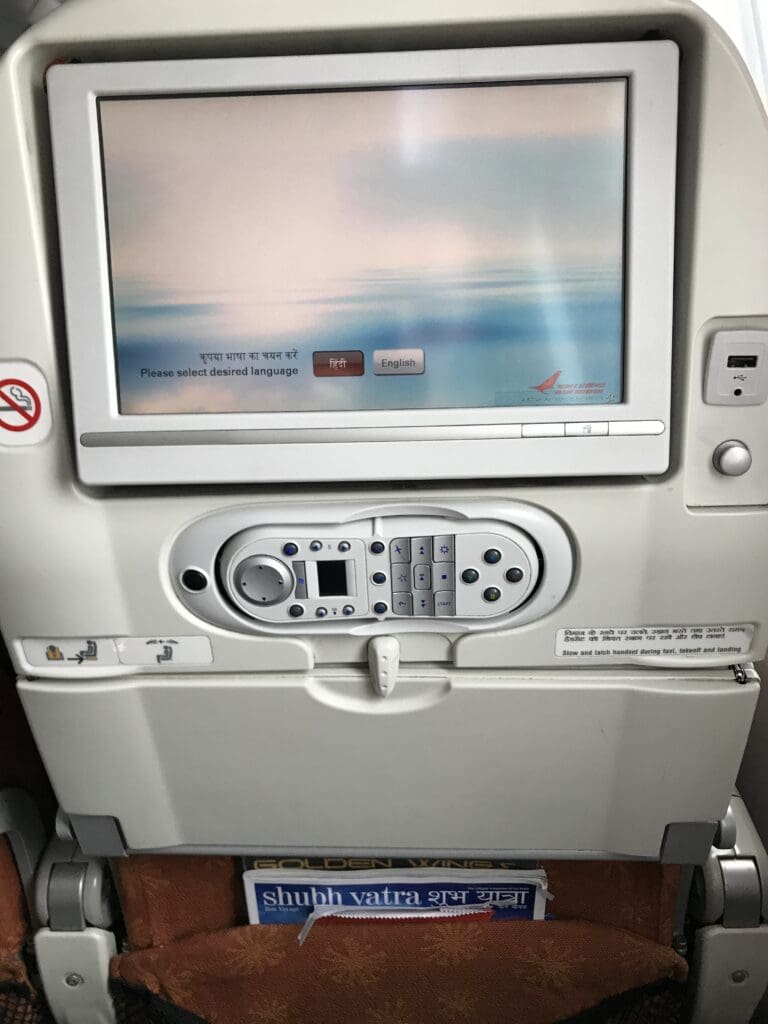
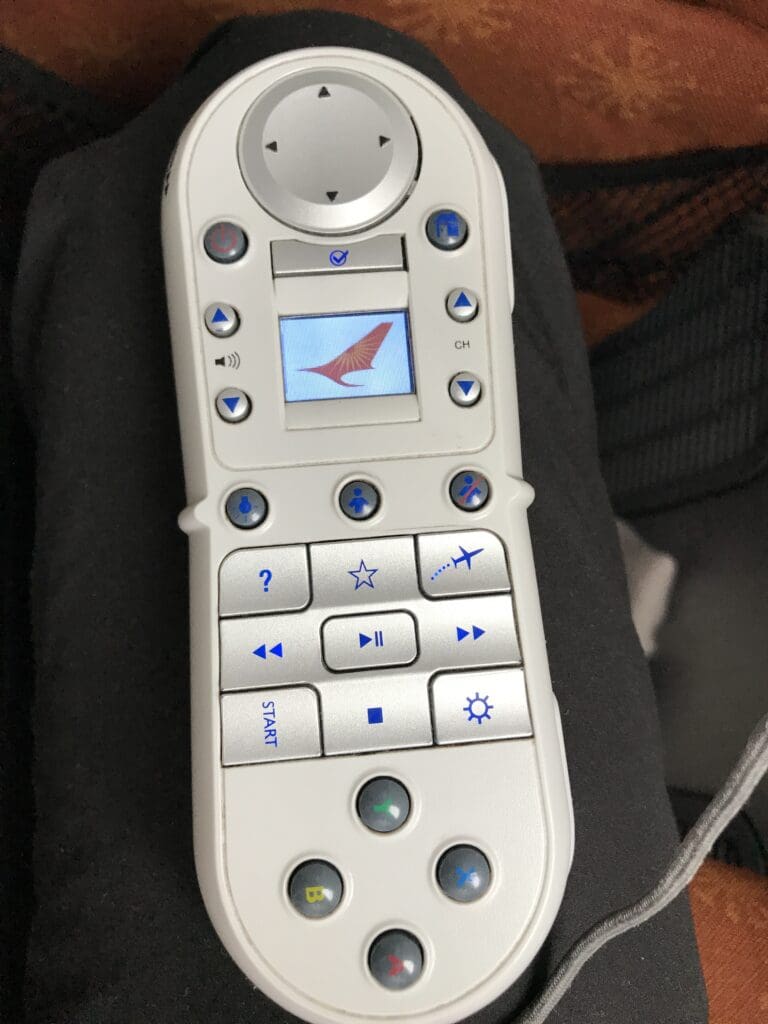
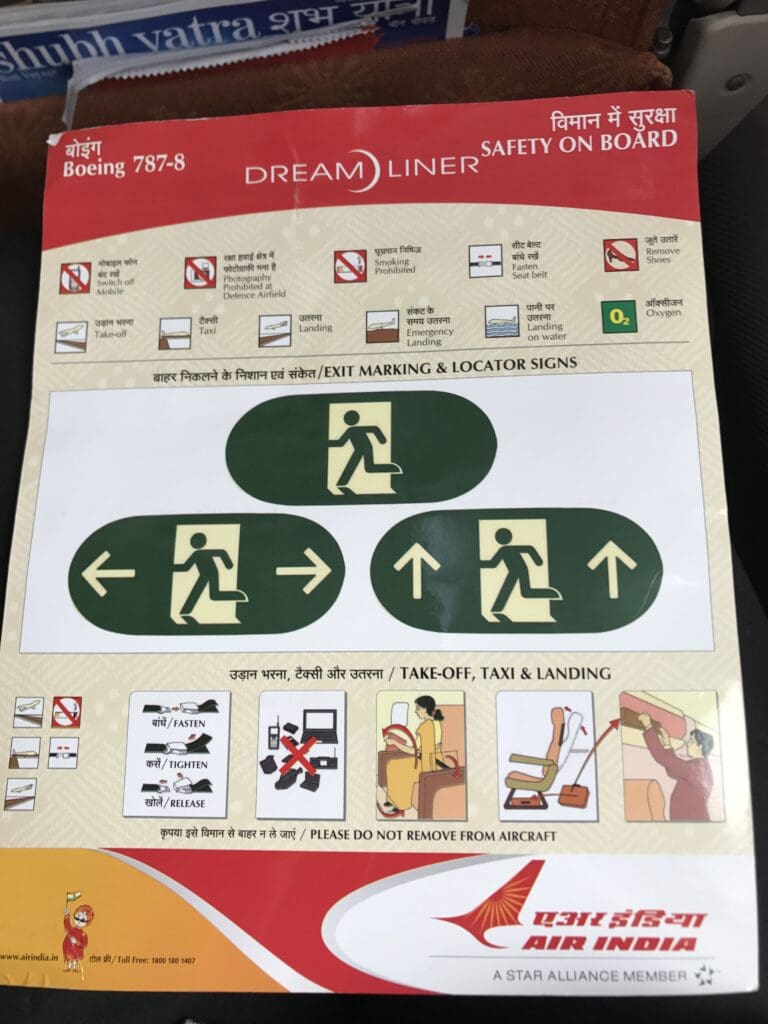
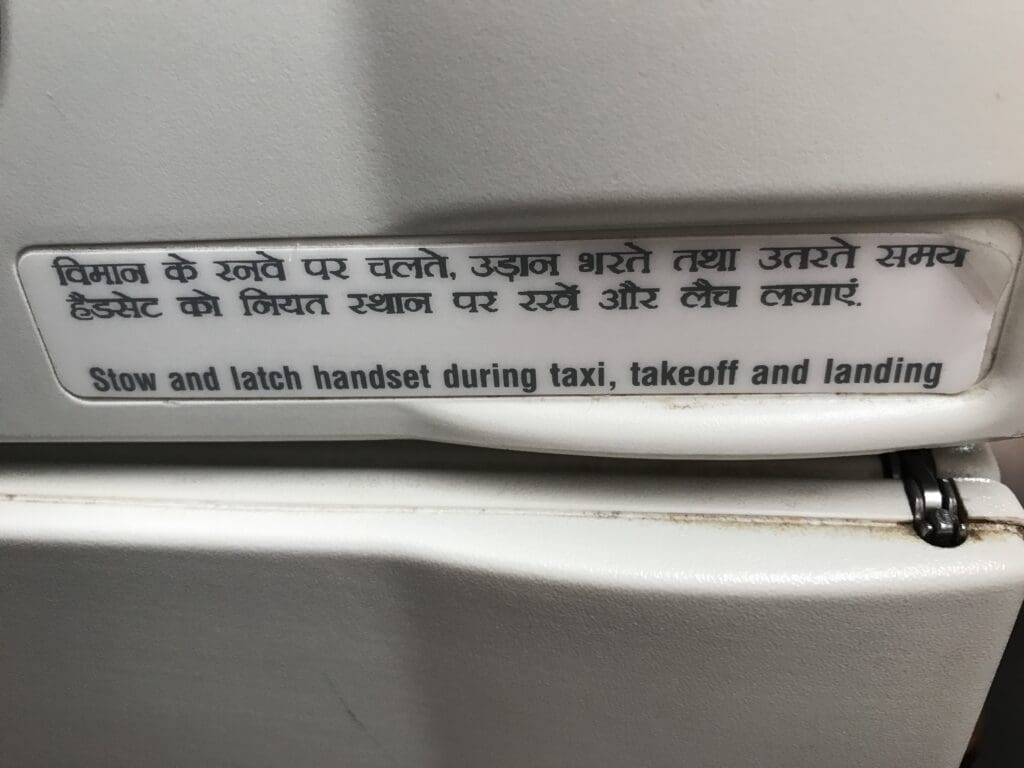
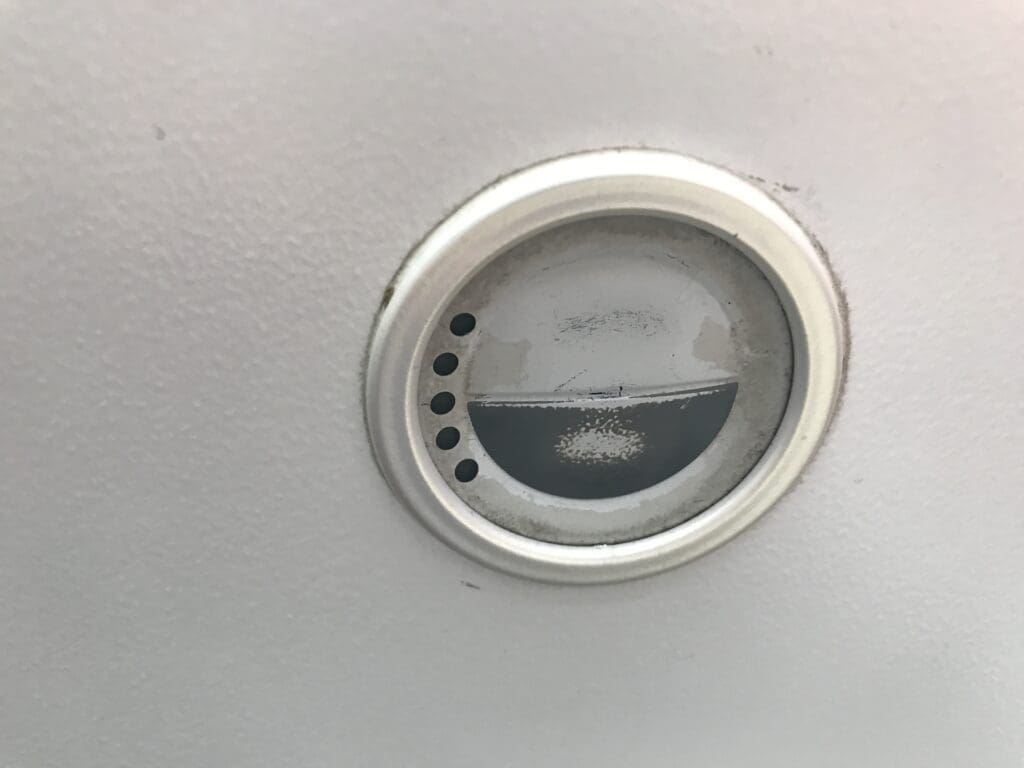
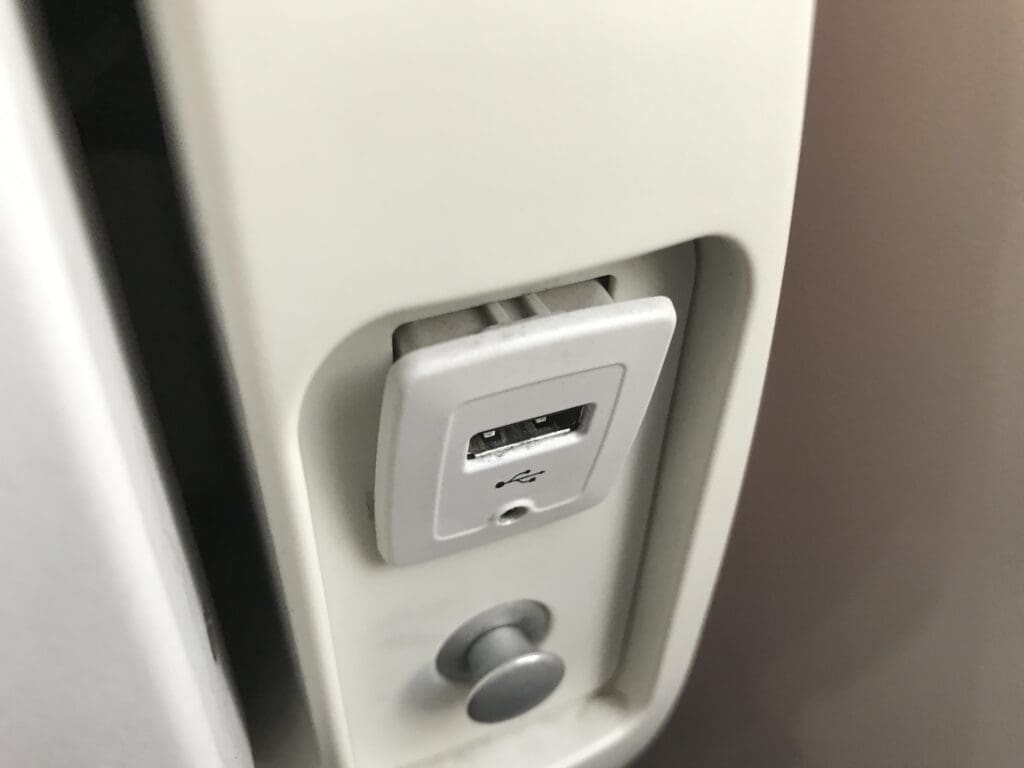
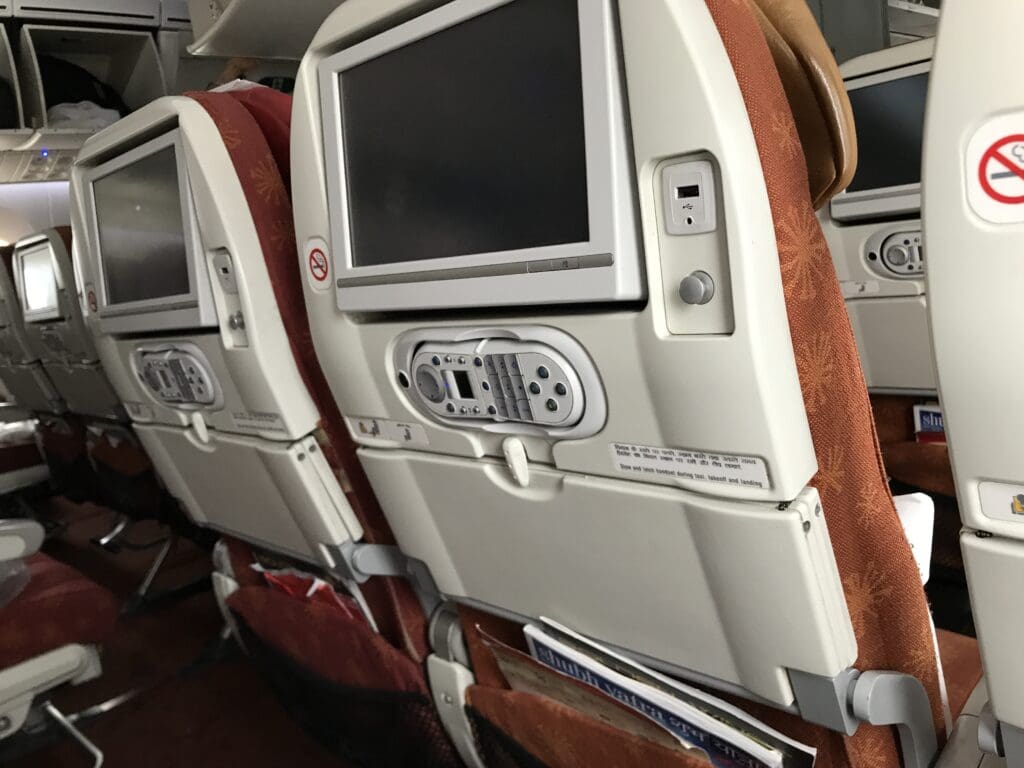
Other than the omnipresent signs of wear and tear, the seats themselves left me with few complaints, with these being spacious, soft and comfortable, leading me to conclude that I would have had no issue with sitting in this for the long three-leg ride to Mumbai. Looking ahead, each seat features a decent-sized inflight entertainment screen powered by Thales’ Top Series i8000 inflight entertainment system. I found this to respond well to touch, whilst this could also be controlled by a large and seemingly overcomplicated remote control located just beneath the screen. For those needing some juice, USB-A ports are located to the right of each screen whilst universal power outlets can be found underneath each seat. Whilst I did not try the latter, I found the USB-A port to work without issue and I was able to successfully charge my phone turning the flight. Turning to the seatback pocket, this contained the July 2017 copy of the airline’s ‘Shubh Yatra’ inflight magazine, the Golden Wings entertainment guide, a pair of low-quality complimentary headphones, a safety card and no fewer than three sick bags!
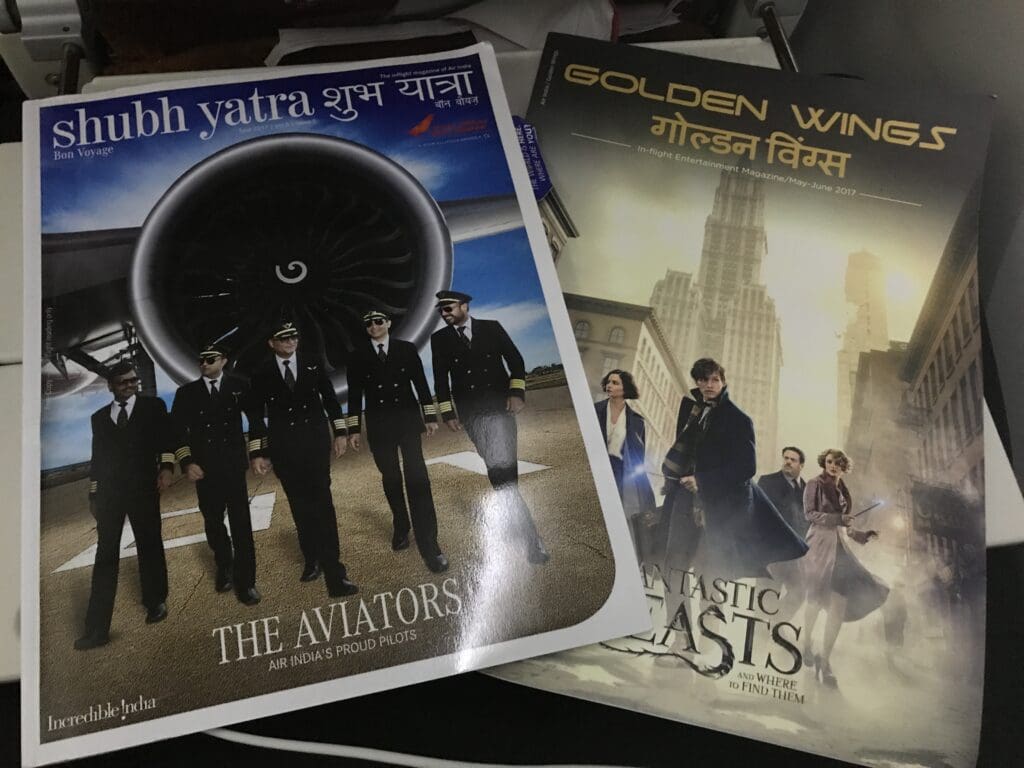
Even though passengers seemed to take their sweet time to board the aircraft, boarding took no more than about twenty minutes. Once the Purser announced ‘all passengers onboard’, I was delighted to see that the Economy cabin seemed to be no more than about 40% full, with many aisles lacking so much as a single passenger. As you would perhaps expect given the route, around half of those in Economy seemed to hail from India, whilst most other passengers were from both Hong Kong and Korea. Moments after boarding had been announced as complete, the Purser performed a long welcome speech in Hindi and English during which they thanked passengers for flying with Air India and apologised for the delay, advising passengers that they could complain about this on Air India’s website, before moving on to detail our flight time and go through the usual messages and warnings. As soon as the Purser’s announcement came to an end, Air India’s relatively long safety video took over the inflight entertainment screens. This was followed by a short Boeing 787-specific information video on how to operate the aircraft’s window shades and inflight entertainment system.
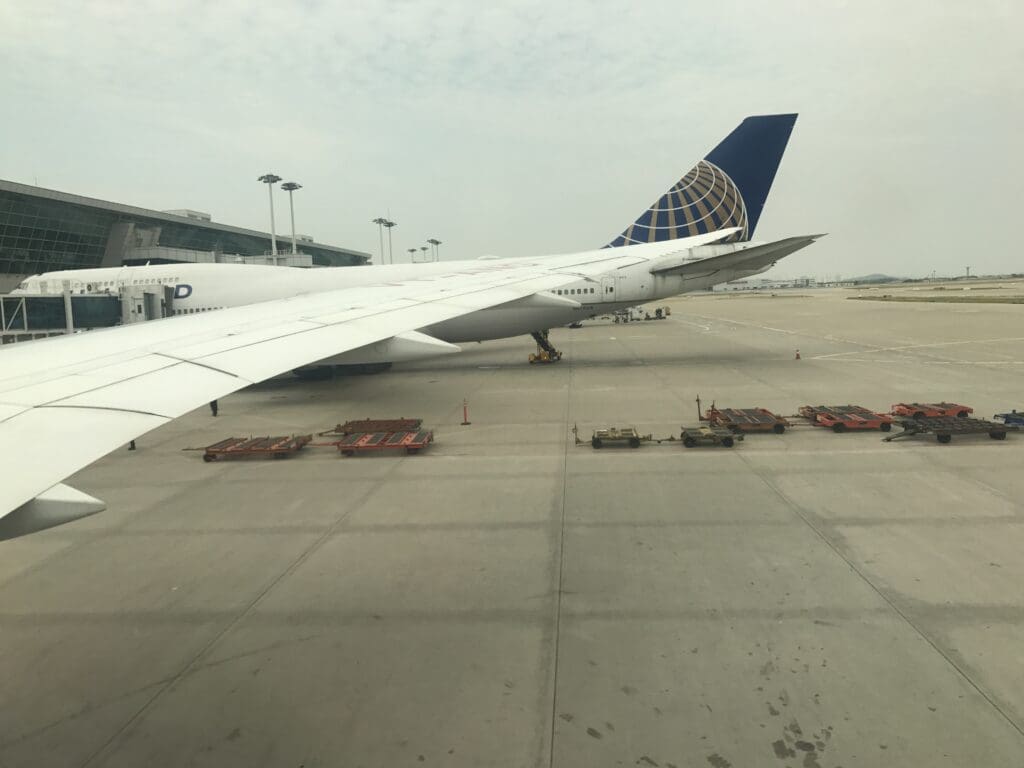
At 1657, a sudden jolt could be felt as the Dreamliner was pushed back away from its parking position. As it made its way away from the terminal, the cacophony of modern whirs and hums rang out through the cabin as the two massive GEnx-1B engines powered into life ready for the 1,284-mile journey to Hong Kong. Following a short pause whilst the tug was disconnected and the engines stabilised, the flaps were partially extended with a loud whine before we began our journey to Runway 33L. During this journey, the cabin crew passed through the cabin making a rather lacklustre attempt at a pre-departure check, with two crew members failing to spot the fact that the passenger in front of me had already fully reclined their seat!
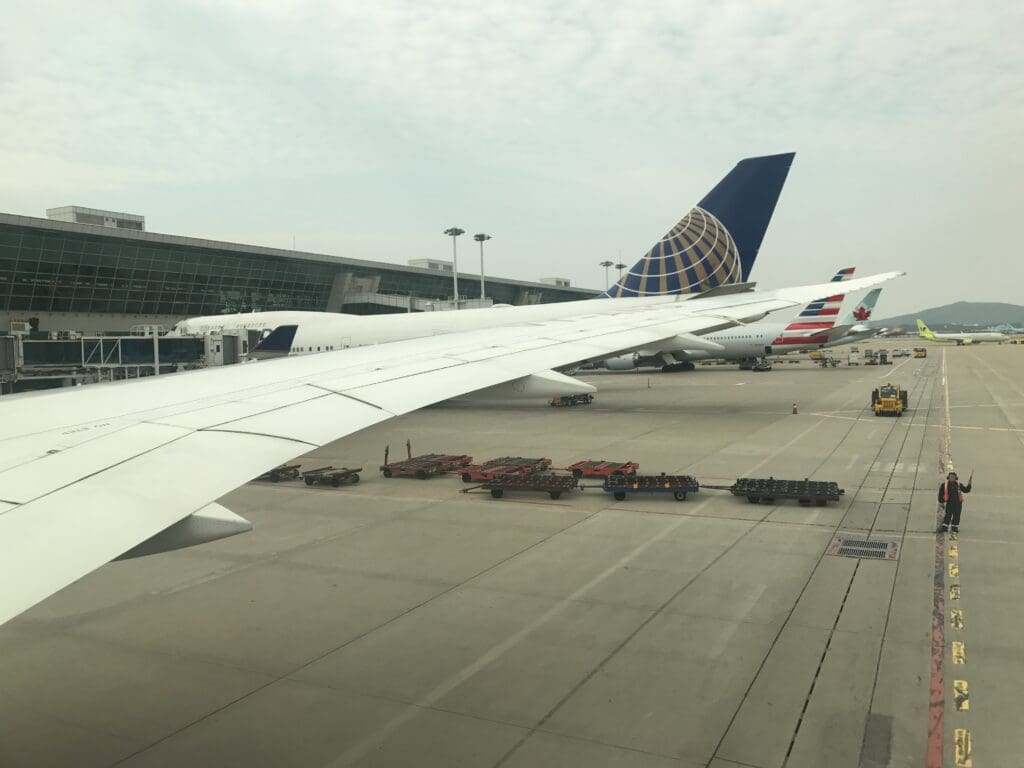
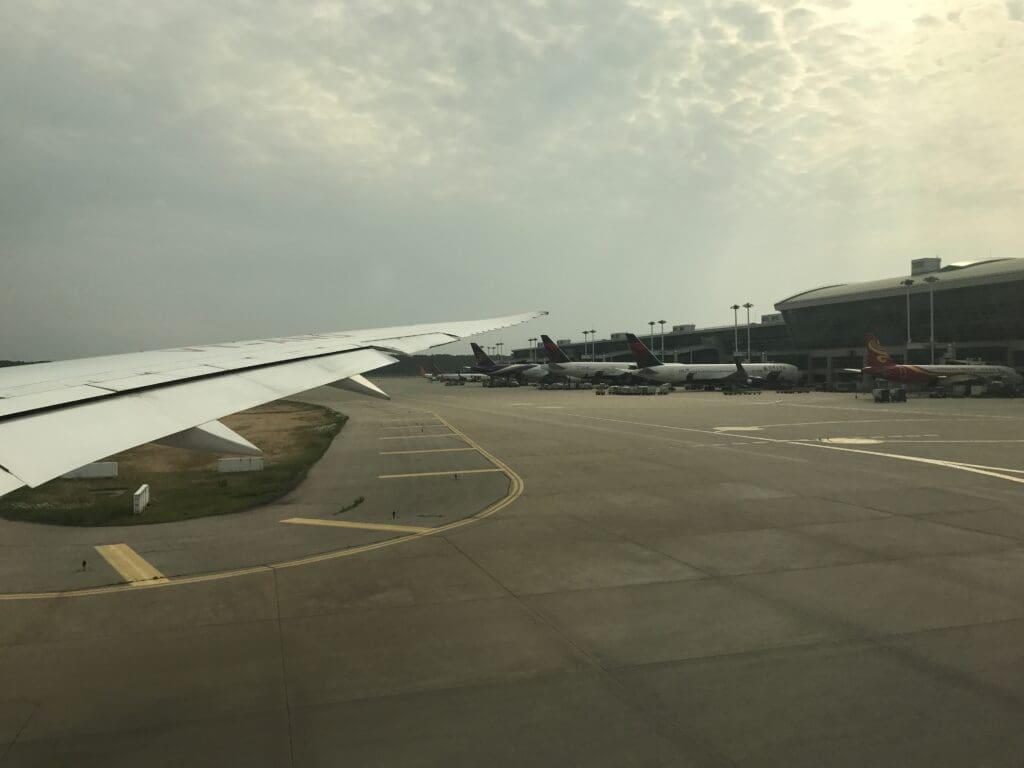
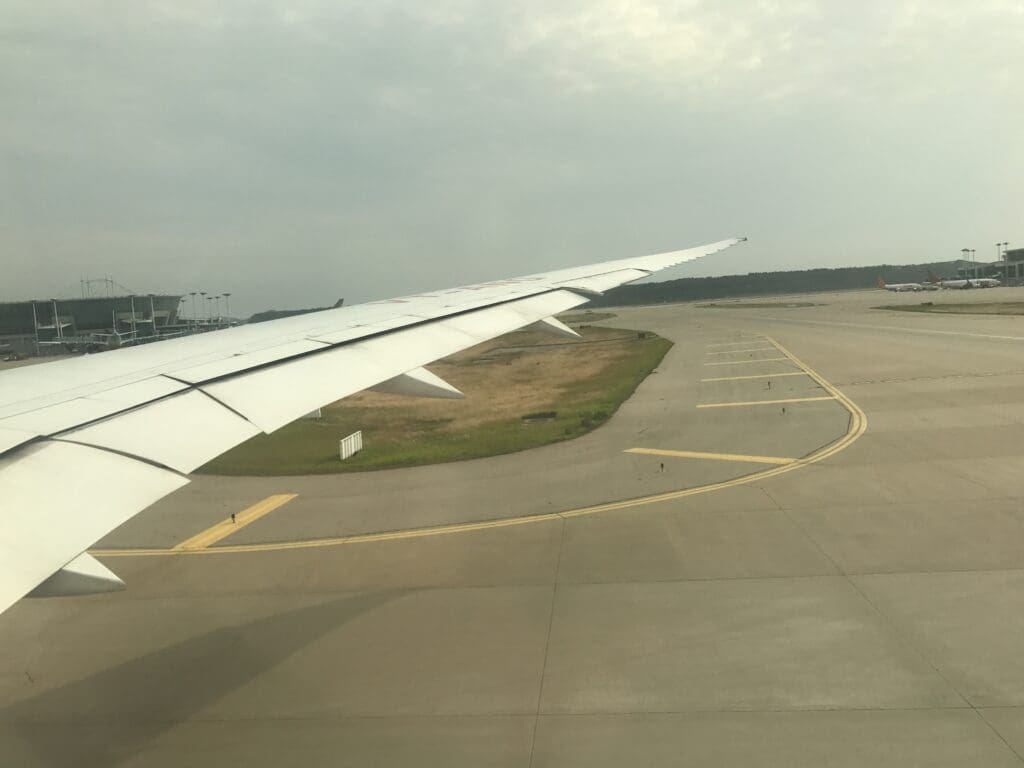
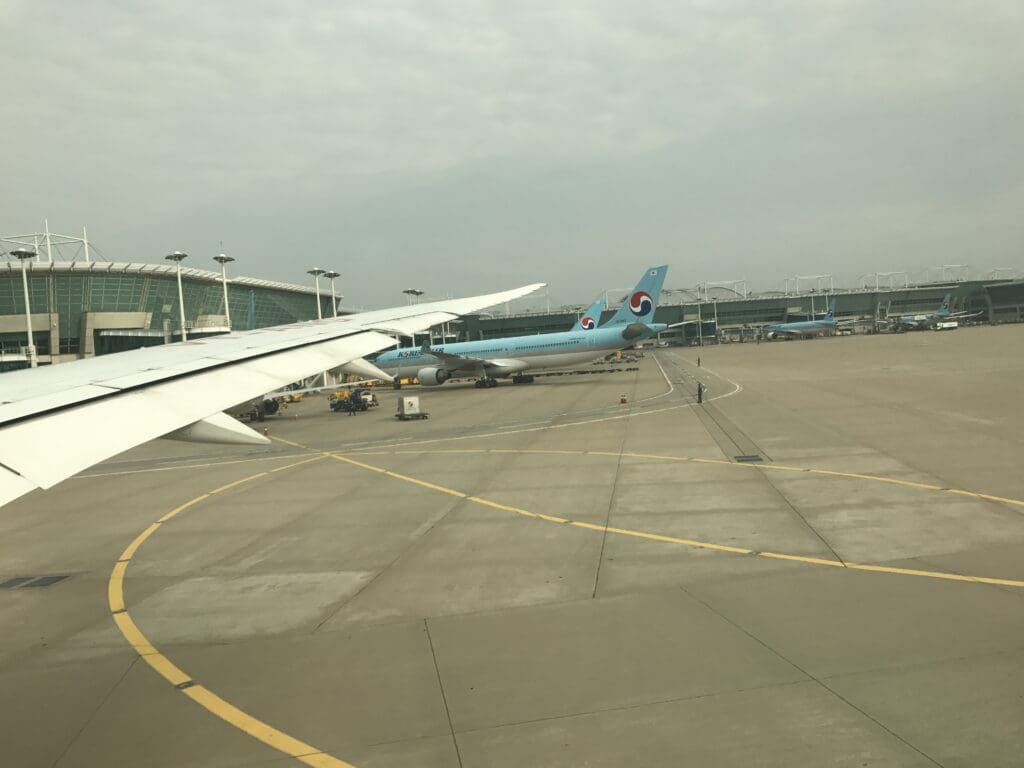
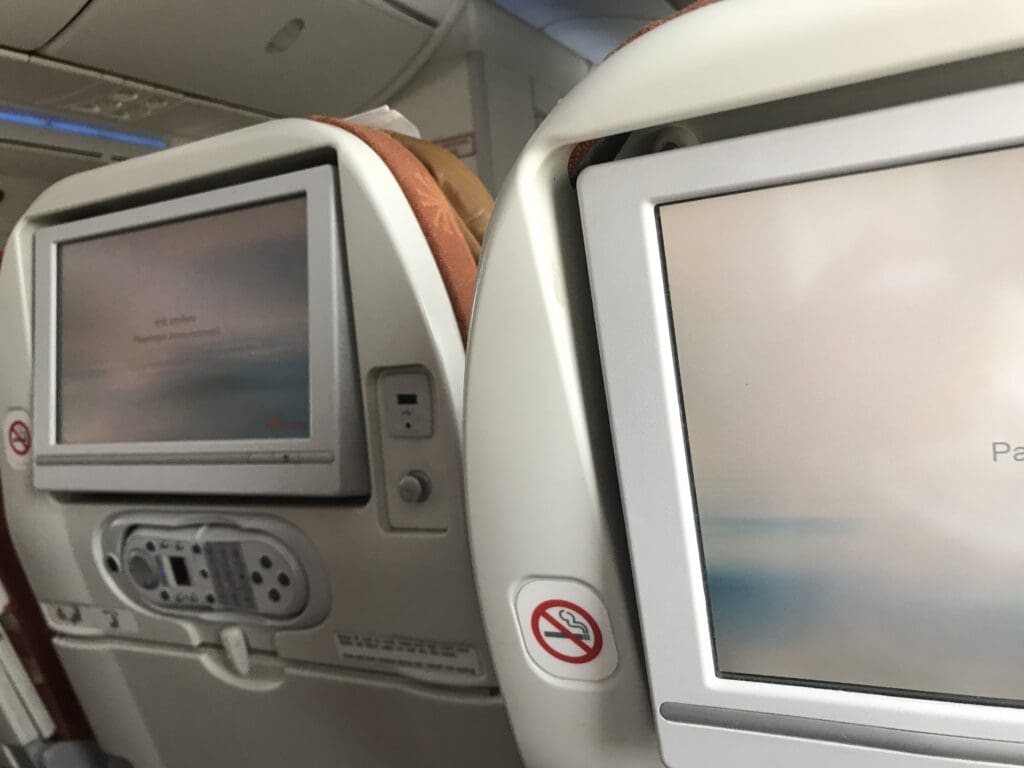
With nothing more than a short taxi in store, at 1712 the Dreamliner made its way onto the runway without any holding and commenced a rolling takeoff. Once the engines had spooled up, unsurprisingly given the light load we rocketed down the runway and performed a rather sporty departure, soon rocketing upwards into the Korean summer skies. During the first few minutes of the flight, a good view of the islands that sit just to the north of Incheon Airport could be seen through the large window, with these taking the form of Sindo, Sido and Modo. However, given the relative proximity of Yeongjeong Island to the Demilitarized Zone, it wasn’t long before the aircraft banked and turned onto a westerly heading to avoid overflying the heavily armed border between North and South Korea.
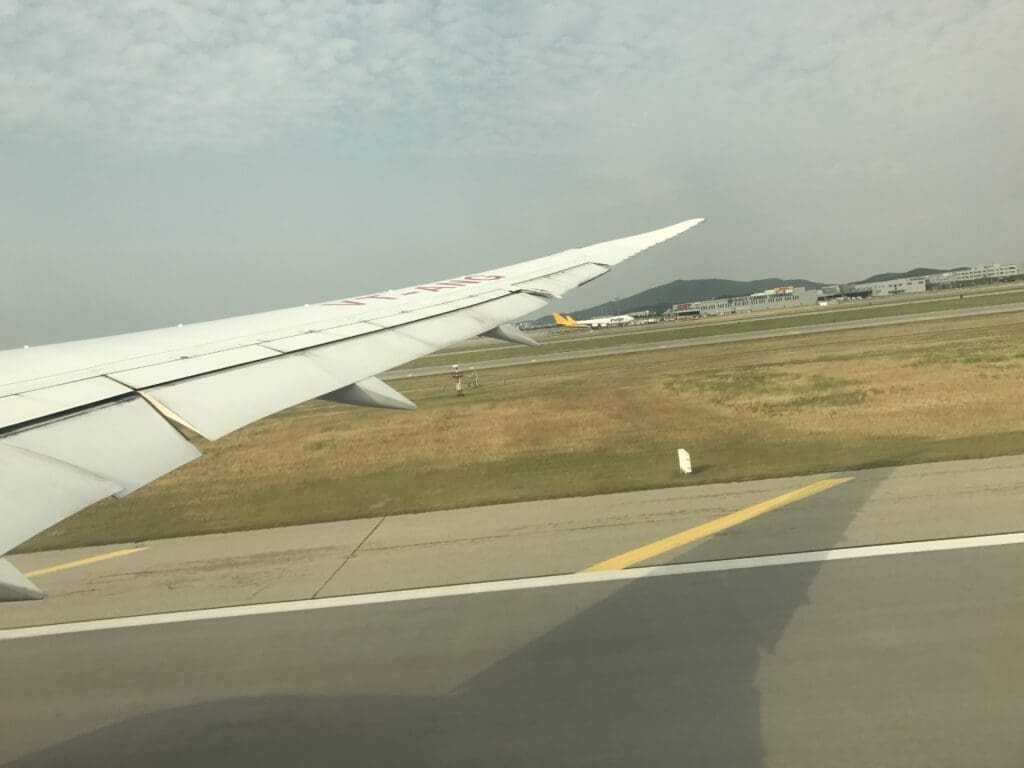
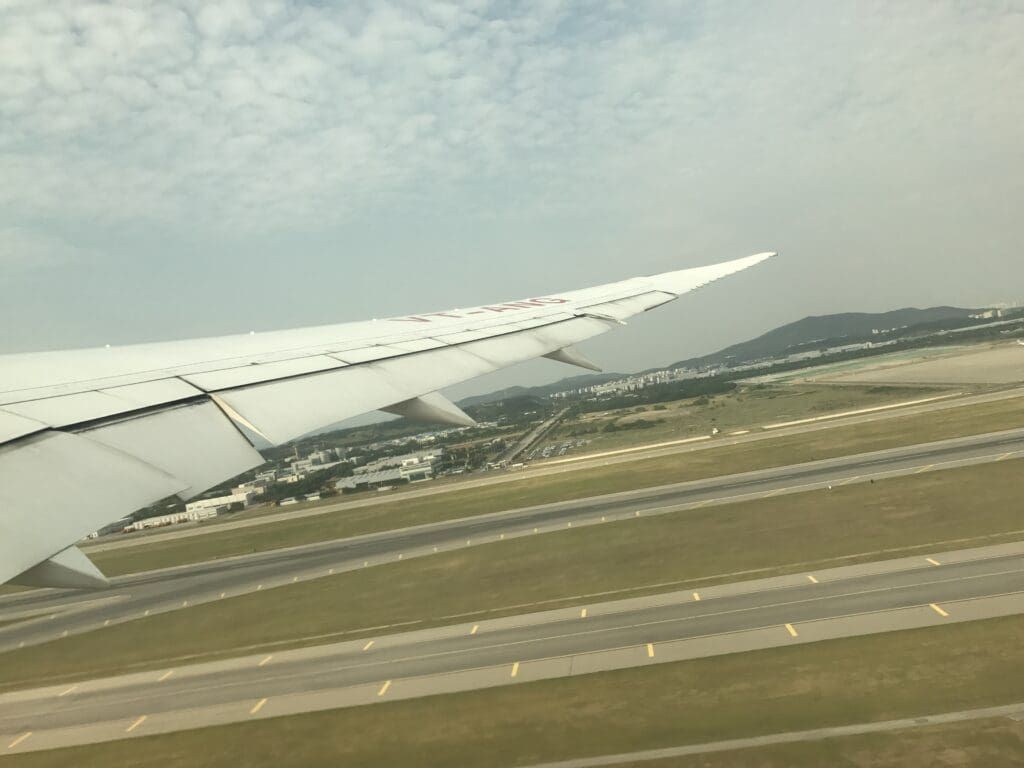
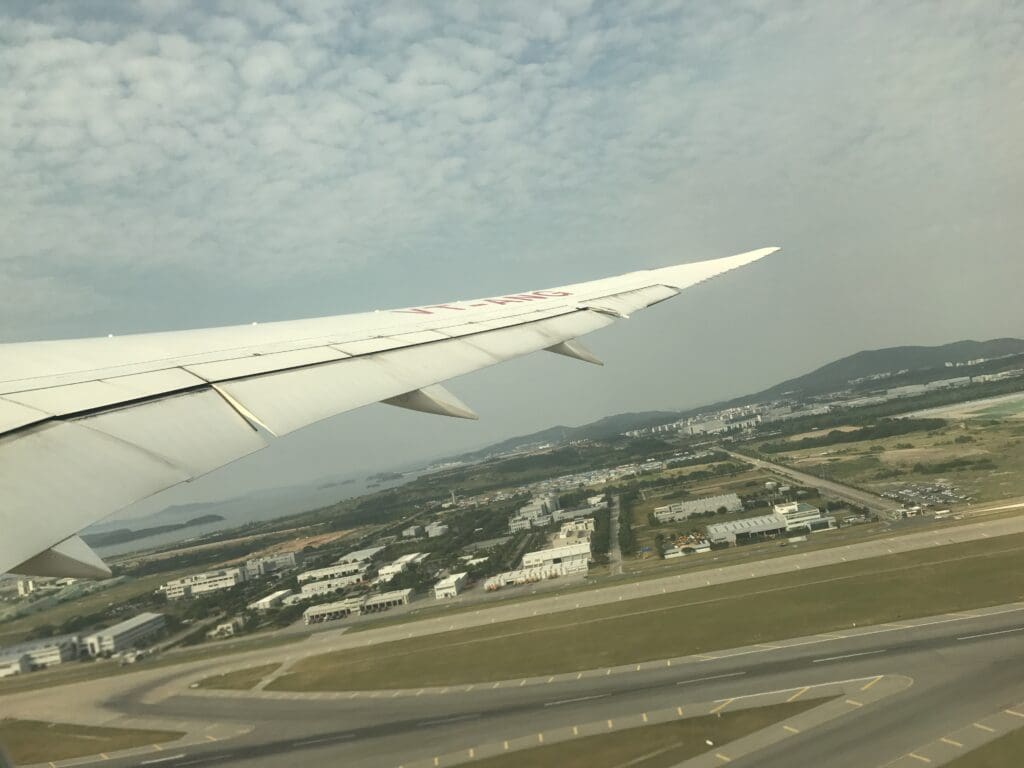
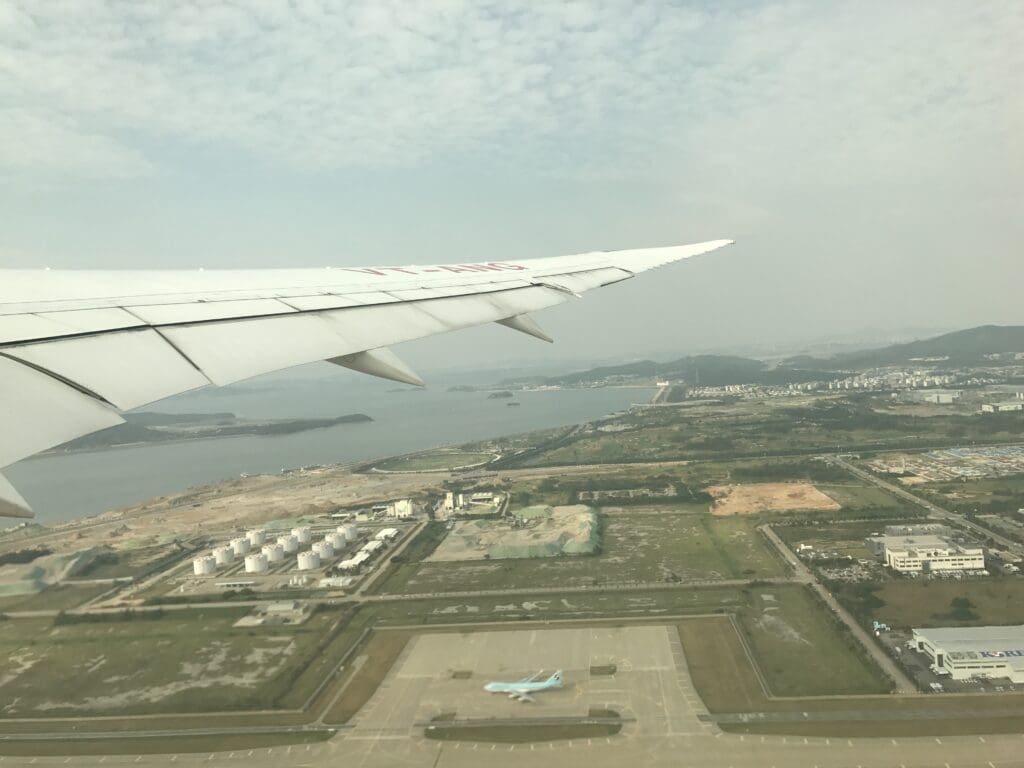
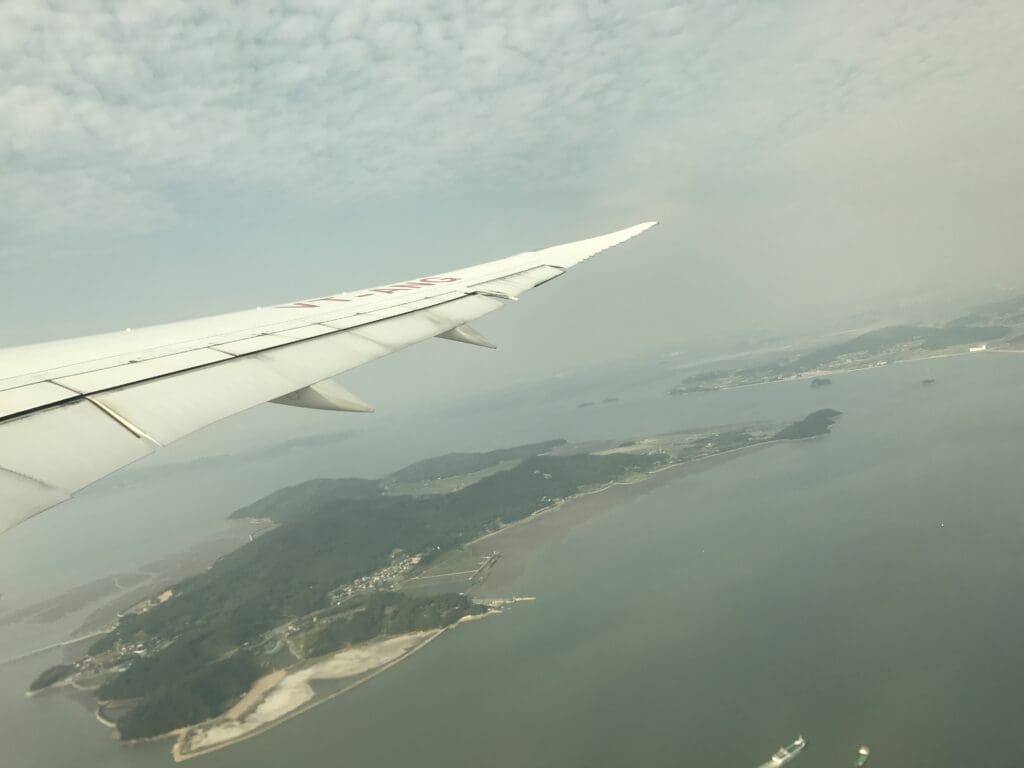
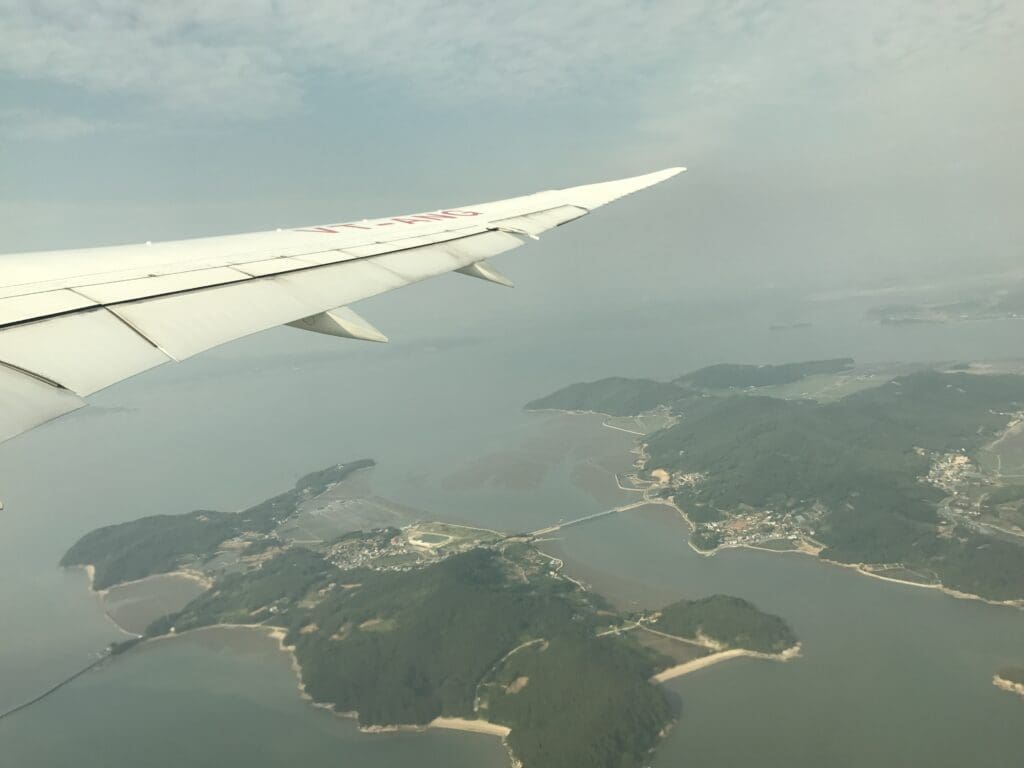
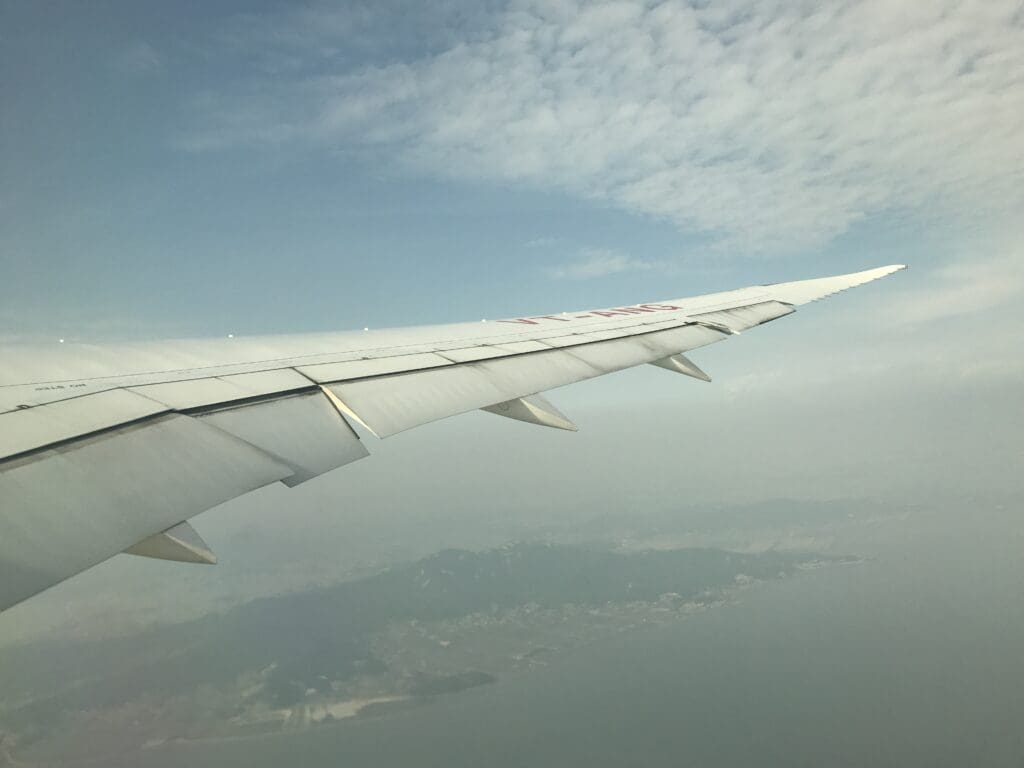
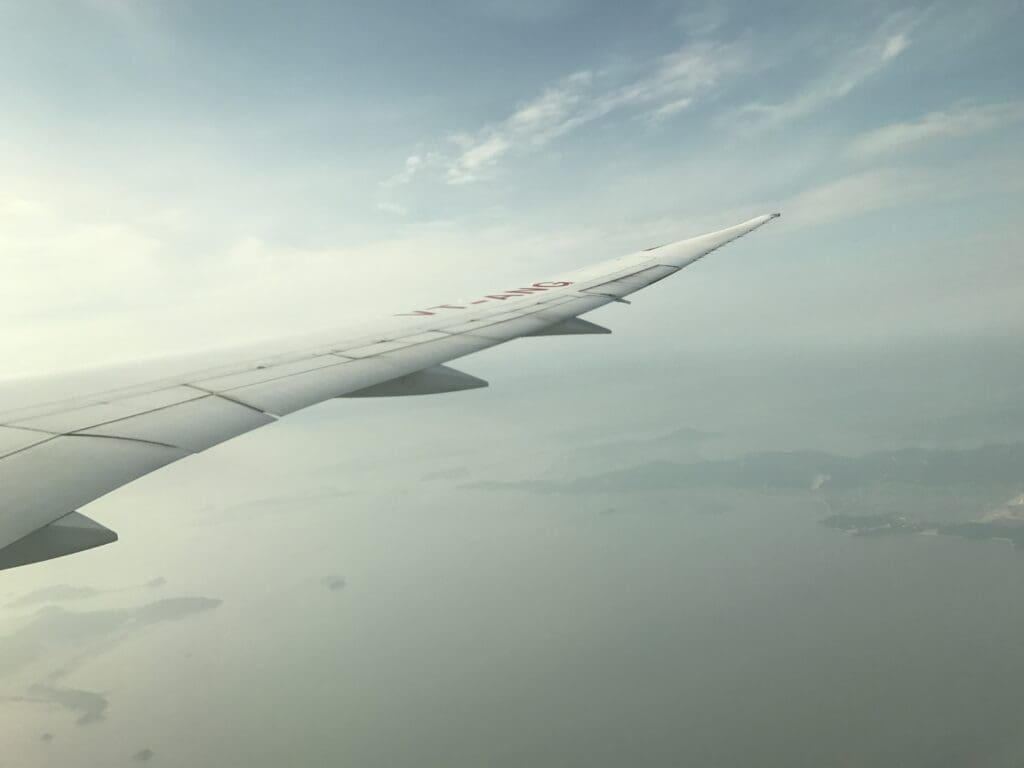
As the Dreamliner climbed through the clouds, the windows were automatically dimmed although thankfully these could be overridden, and thanks to the lack of passengers around me, I did not feel bad about setting these to their fully transparent setting. After a few lumps and bumps, we emerged from the clouds at which point the seatbelt signs were extinguished. This was accompanied by an announcement from the Purser advising passengers to keep their seatbelts fastened whilst seated before giving a promotional speech on Air India’s Flying Returns frequent flyer program.
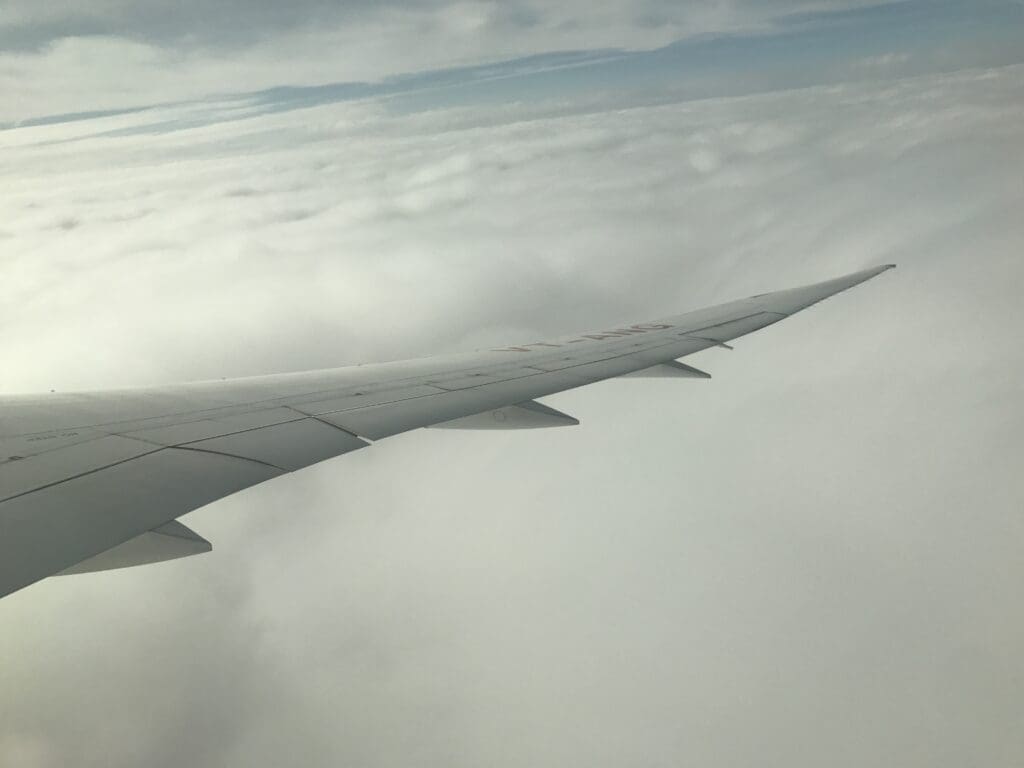
Making a smooth climb, it wasn’t long before the Dreamliner levelled off at 40,000 feet at which point the inflight service commenced. This started with a round of drinks and upon reaching my row I was served by a very polite and friendly flight attendant who asked for my choice of drink. Opting for an orange juice, this was cautiously poured into a plastic cup before being placed on my tray table along with an Air India branded bag of peanuts and a serviette. Perhaps looking famished, I was then asked if I would like another drink or another bag of peanuts! However, I rejected this offer and the crew member continued on their journey down the cabin.
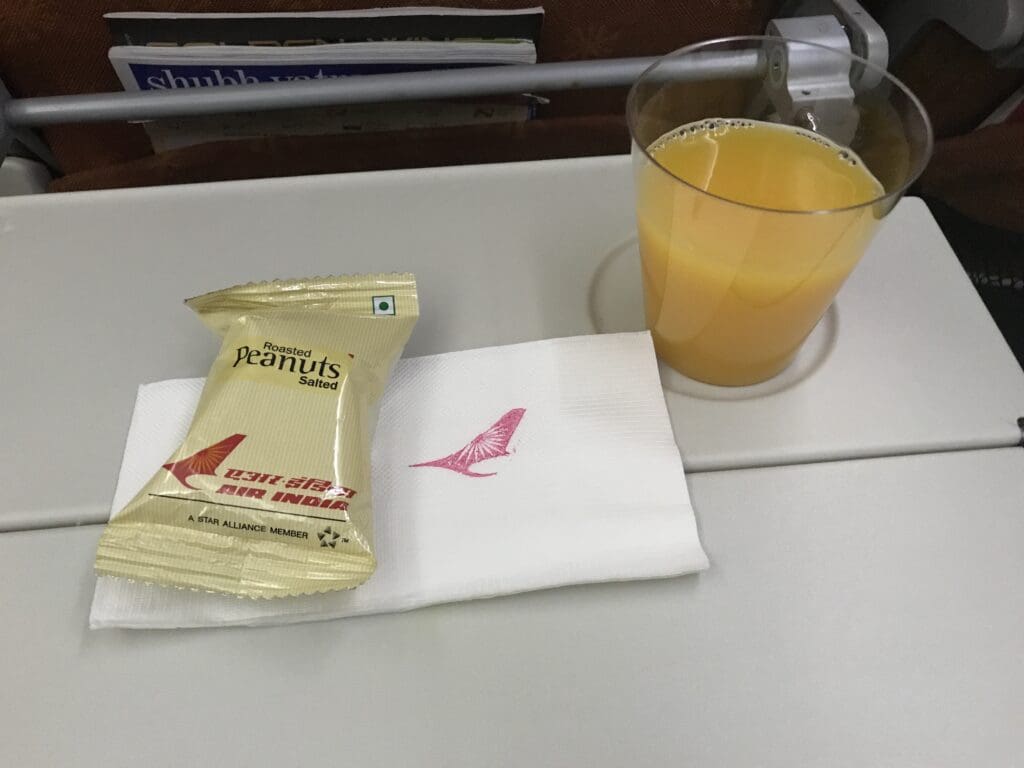
At 1800, the crew passed through the cabin collecting the rubbish from the drinks round and fifteen minutes later, service carts hit the aisles once more and the evening meal service commenced. Given the lack of menus, either online before the flight, paper menus or digital menus on the inflight entertainment system, I wasn’t too sure of exactly what would be served on the ride down to Hong Kong. However, all became a little clearer when I was asked the question ‘Indian vegetarian meal or fish?’ . Not being too sure of what the fish dish entailed, seeing as I was flying on Air India I decided to keep things local and went for the Indian option before being offered another drink. Soon, a tray of food was handed over to me and I soon got to work examining its contents. This featured a main dish complete with small portions of paneer curry and vegetable curry separated by a portion of rice, a warm paratha, a salad accompanied by a packet of Heinz Italian dressing, a cold packaged bread roll with a packet of butter and a dish containing the traditional Indian dessert, gulab jamun. This also came with a small plastic tub of Kowloon Dairy milk, hinting that the meal had spent the afternoon on the aircraft having been loaded in Hong Kong. Meanwhile, eating utensils came in the form of flimsy plastic cutlery.
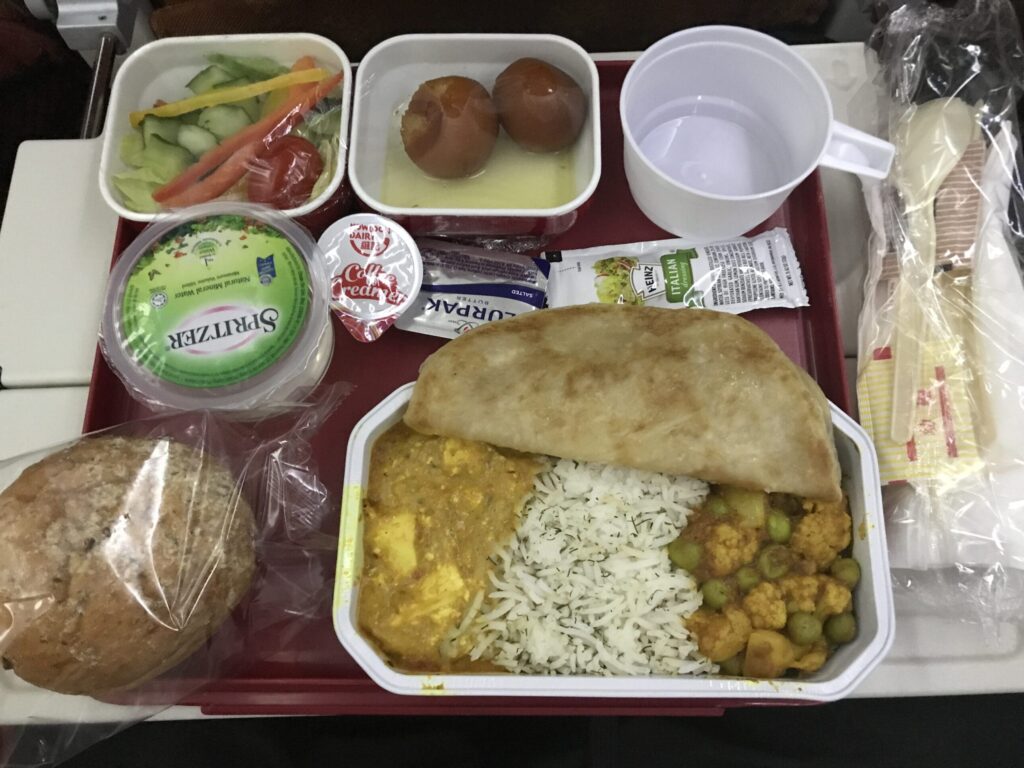
Once delivered, I soon got stuck into dinner and was relatively pleased with the main curry offering which reminded me of the typical supermarket curries I had regularly consumed back in the UK, although the rice did seem to be a little dry. Turning to the breads, the warm paratha served to complement the main dish well, although the same could not be said for the cold bread roll which was tough, chewy and largely lacking in taste. Turning to the salad, this seemed to be entirely standard whilst the dessert was delicious and served to end the meal on a positive note. Fifteen minutes after this meal had been handed to me, yet another drinks round was made, although options this time were limited to coffee, tea and water, and several minutes later the crew passed through the cabin collecting the remains of the service.
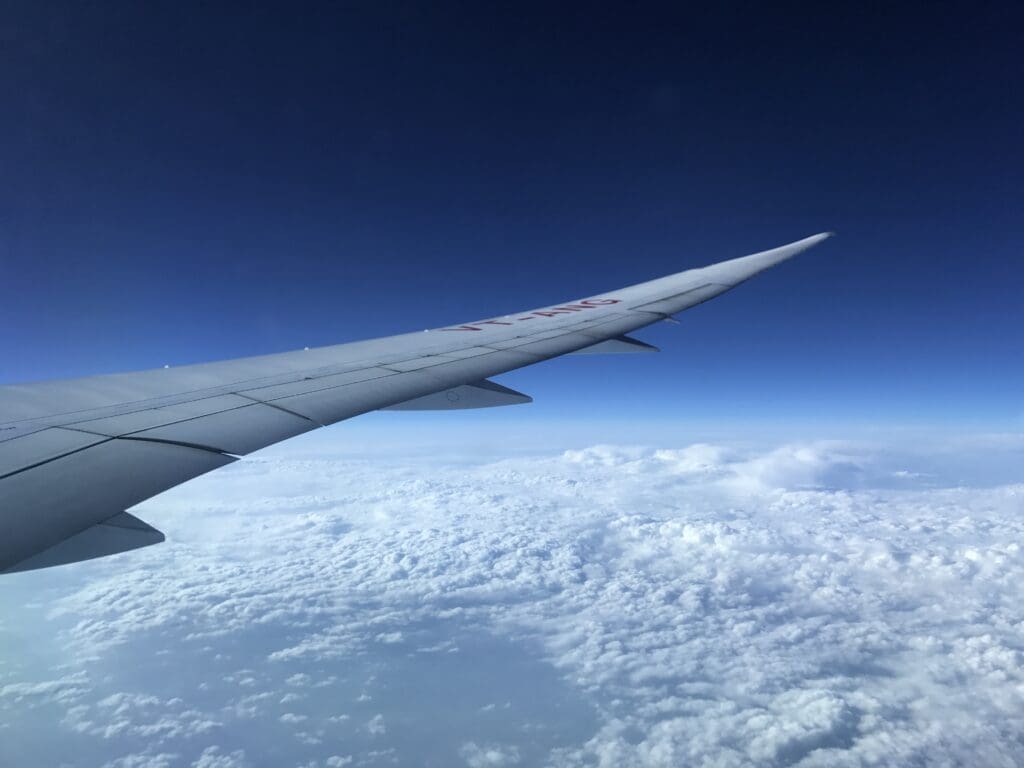
Once my tray had been collected, with clouds still lingering below, I decided to explore the delights of Air India’s inflight entertainment system. Starting with the basics, considering Air India’s worldwide route network, I was a little surprised to find that this system was available in just two languages – English and Hindi. Meanwhile, I found the system to be rather basic and dated in its layout, however, on the flip side, this was reasonably easy to navigate. Turning to the selection of content, fans of Indian and American cinema would have not been disappointed with 148 and 52 such films offered respectively. However, options that fell into neither category were highly limited with a single film each from China, Egypt, France, Germany, Italy, Japan, Korea, Russia and Spain. Aside from this, the system featured a plentiful catalogue of 165 television programmes, 51 music playlists, 20 games and 3 audiobooks. Unfortunately, that day the moving map did not work, and, given the lack of cockpit announcements and the omnipresent cloud cover below, tracking the flight’s progress was a near-impossible task.
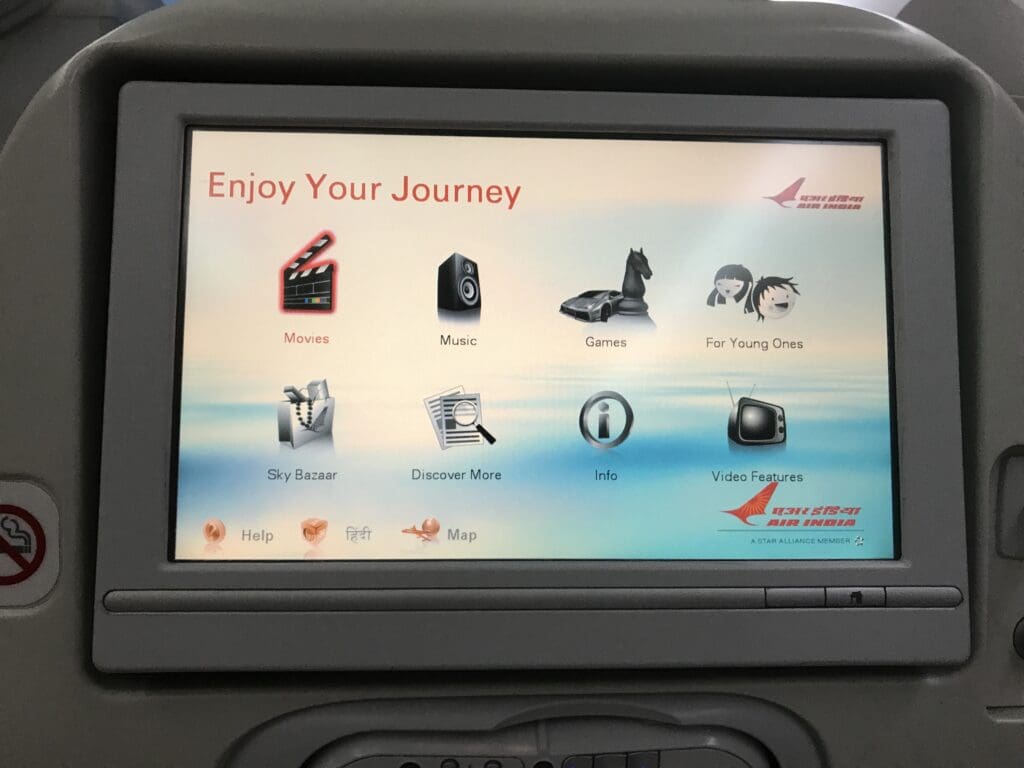
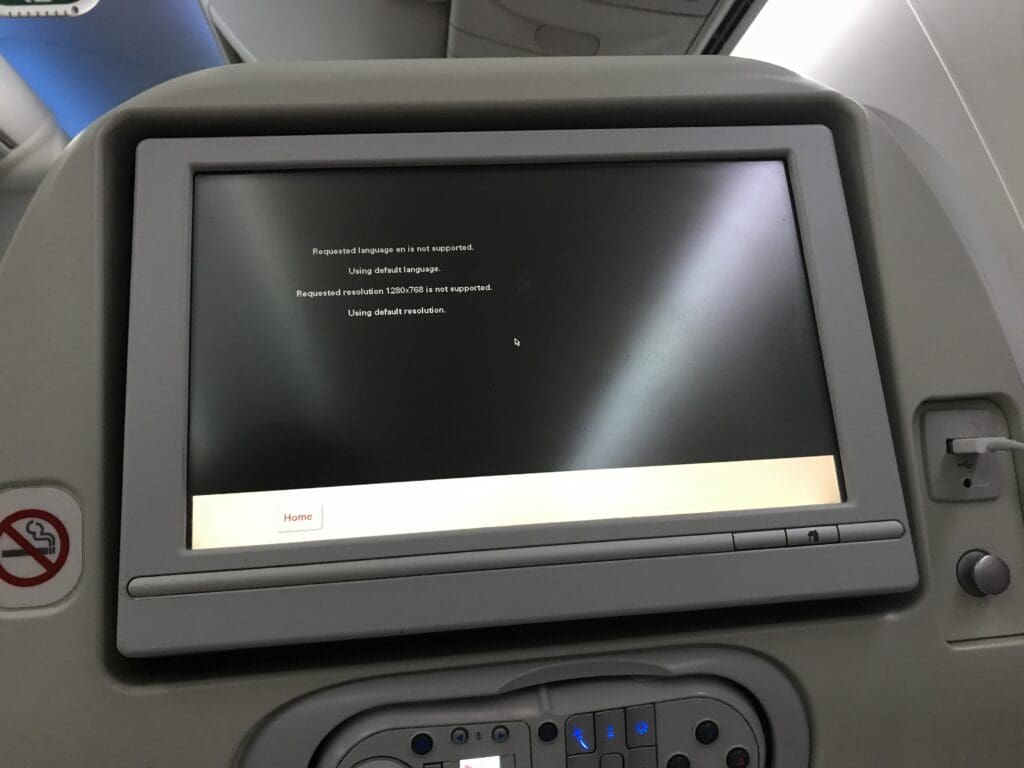
As the Dreamliner trundled southwards through Chinese airspace, I assumed that we were taking one of the two standard routes between Incheon and Hong Kong. These involve flying down Korea and over the island of Jeju before either heading for Shanghai or Taiwan. However, that afternoon the aircraft took neither of these and instead flew a relatively indirect route. Following departure, the Dreamliner continued on a westerly heading towards China, passing over the Shandong Peninsula and towards the capital of Shanxi, Taiyuan. Upon reaching this, the aircraft flew southwards and made its way down Eastern China, passing the likes of Changsha and Wuhan.
Once the remains of the dinner service had been removed, the crew disappeared into the galleys and were not seen until the aircraft had commenced its descent. Meanwhile, the lights were dimmed and many passengers seemed to take advantage of the many empty seats, wrapping themselves in blankets and sprawling across the aircraft’s empty rows. Others seemed to pass the time by watching content on their own devices, whilst few appeared to be making much use of the inflight entertainment system. Not particularly drawn to the idea of getting stuck into anything on the inflight entertainment system and with little to see outside, I turned to Air India’s Shubh Yatra inflight magazine. This particular edition featured the usual selection of culture and travel articles published in Hindi and English alongside an interesting article focusing on several of Air India’s pilots. These were interspersed by what seemed to be an above-average number of advertisements, many of which advertised higher educational institutes.
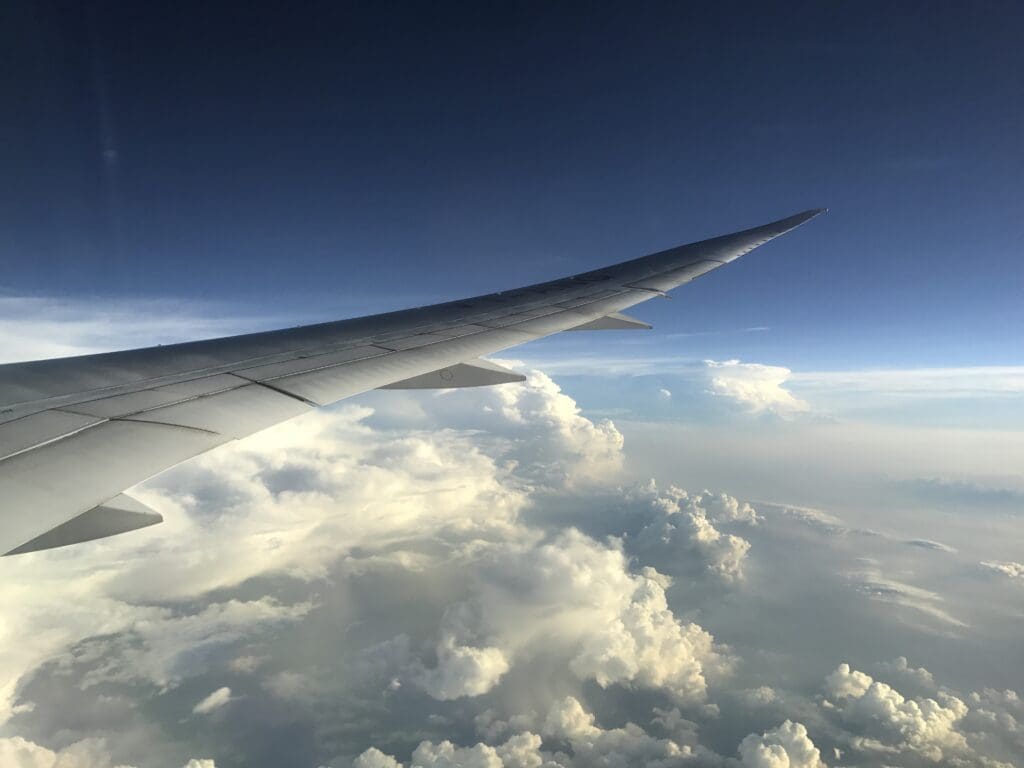
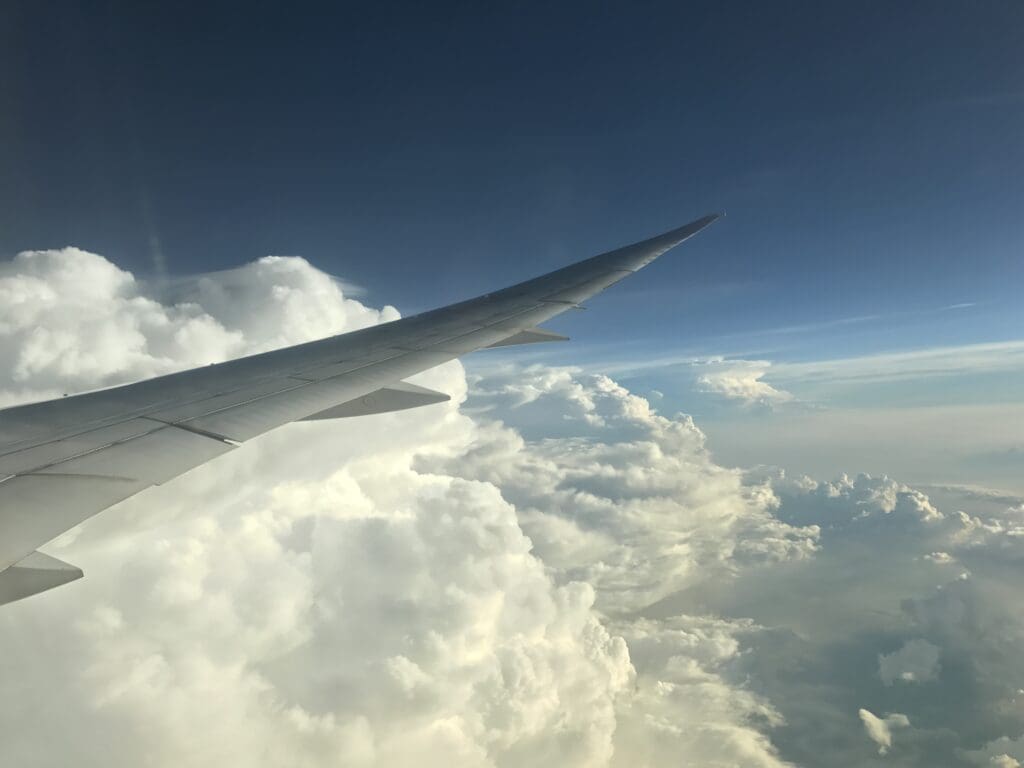
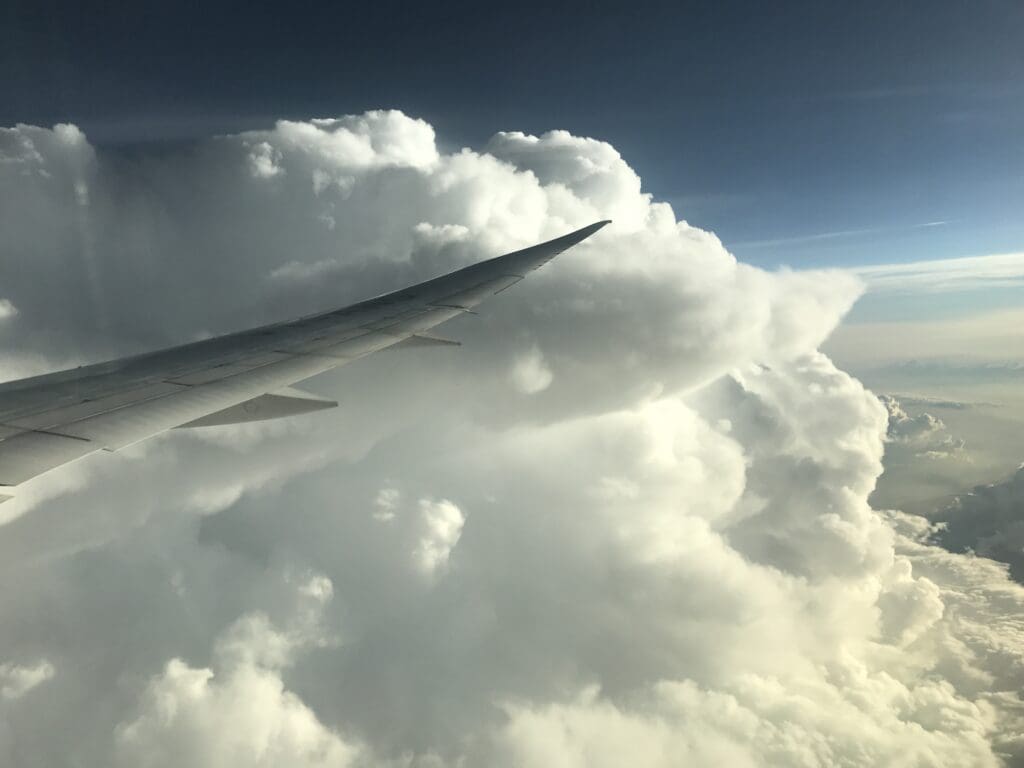
As the sun began to sink towards the horizon, the Boeing 787 continued its reasonably smooth crossing of Southern China, and at 1910 Hong Kong time, the clouds below opened up revealing Guangdong’s hills and the winding Beijiang River. Foreseeing the impending commencement of our descent, I decided to head to one of the lavatories at the rear of the aircraft. In total there are six lavatories onboard Air India’s Boeing 787-8 Dreamliners that can be used by those travelling in Economy, this equates to a very decent ratio of 40 passengers per lavatory. For comparison, a 189-seat all-economy Boeing 737-800 has a ratio of 63 passengers per lavatory. Despite being in a reasonably clean state, like much of the cabin, this was battered – most notably, a large piece of plastic panelling could be seen partially hanging off beneath the sink.
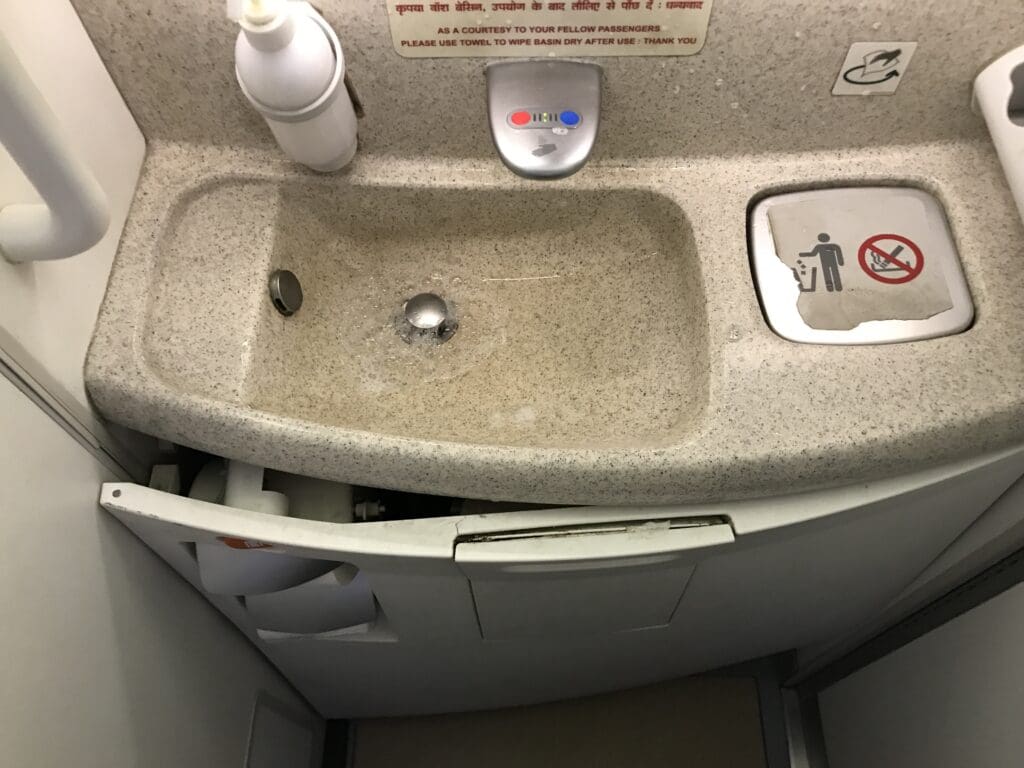
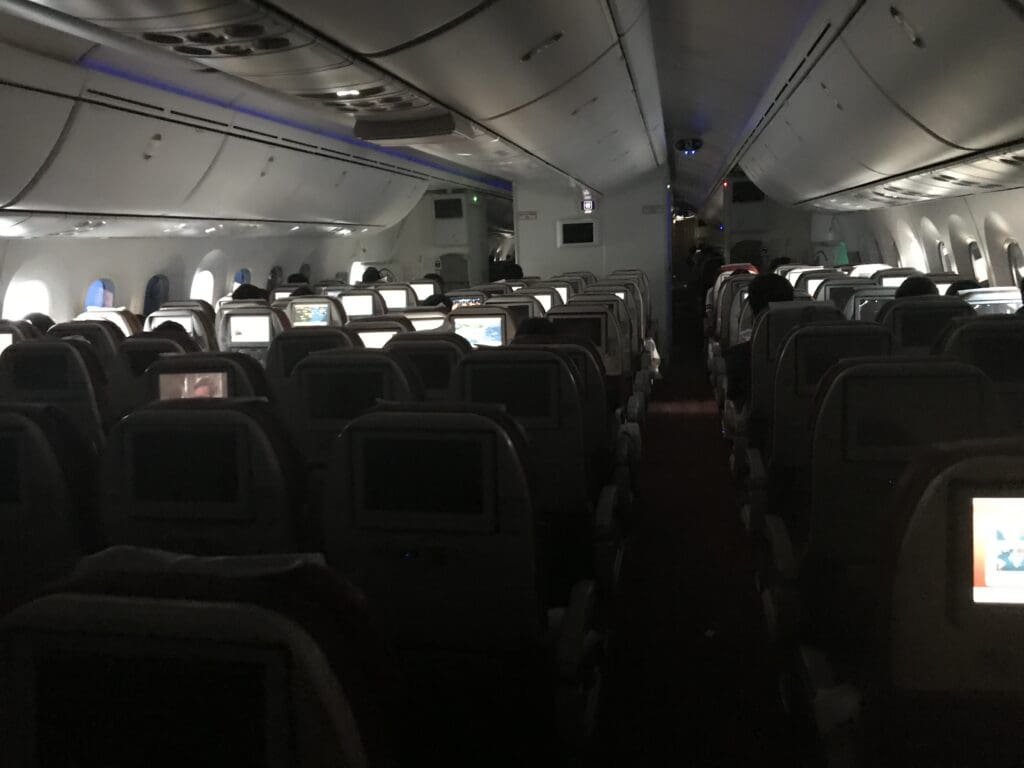
Once I returned to my seat, the crew made an annoucnement requesting passengers to be seated whilst the cabin was sprayed in preparation for our arrival into Hong Kong and reassured passengers that this would be of no harm. As they wandered through the cabin at 1920 the seatbelt signs were reilluminated and followed by an announcement from the purser with the usual advice regarding seatbelts, seatbacks and tray tables before the cabin lights were turned back on at full blast. Soon, the cabin crew passed through the aisles ensuring that all was secure and in place for our arrival into Hong Kong, however once again, this seemed to be done with little effort, failing to spot the fact that the passenger in front of me still had their seat fully reclined.
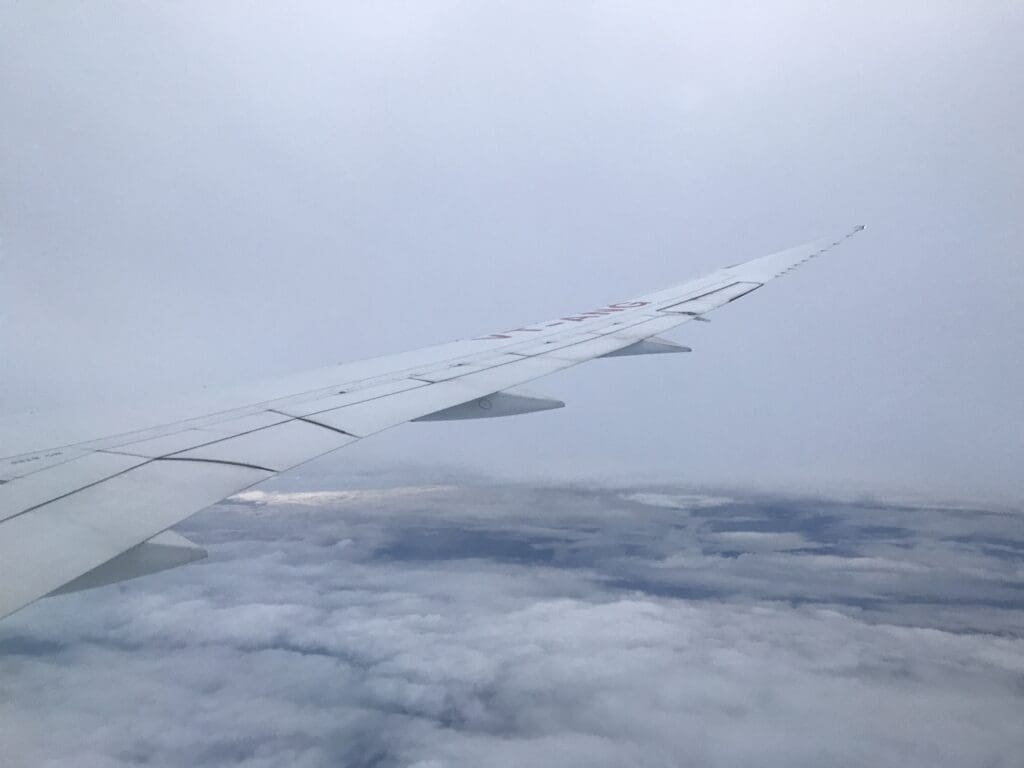
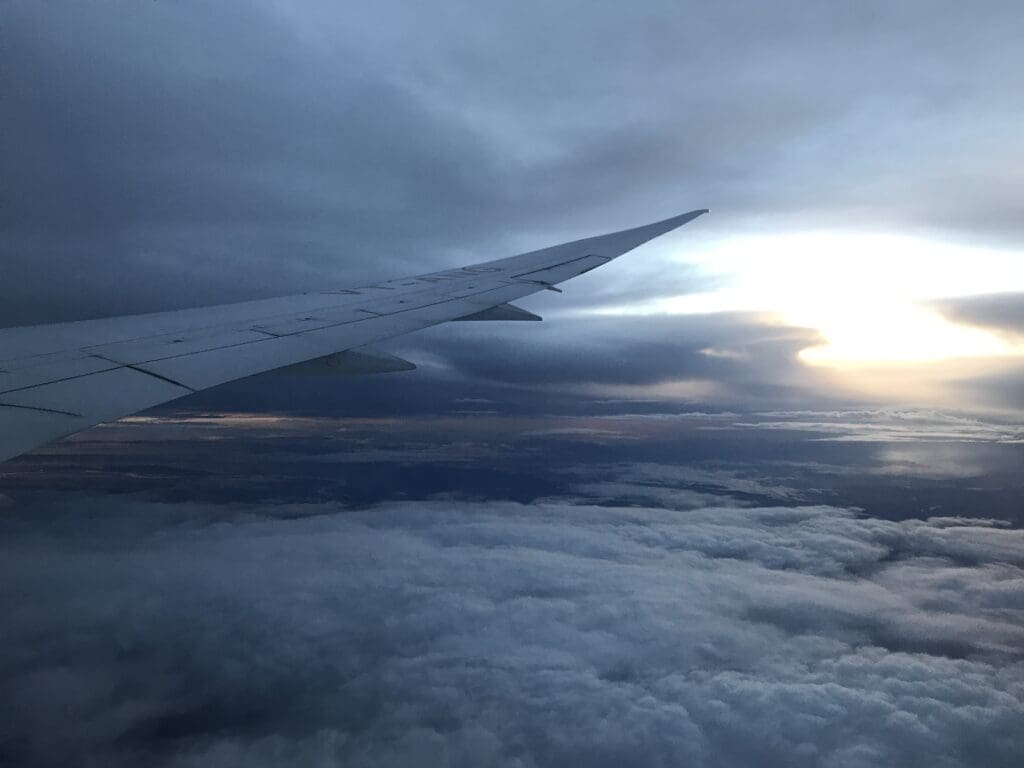
Several minutes after the Dreamliner had commenced its descent, the inflight entertainment screens were temporarily locked and a video reminding passengers of the various emergency exit signs was broadcast. Whilst this was most certainly not a bad idea, I could not help but think this video would have been somewhat unnerving to any nervous flyers onboard! As the aircraft continued its descent, the occasional cloud would flash with lighting, indicating that the approach may be a little bumpy. Upon reaching the tops of the clouds, my suspicions were proven correct and the aircraft ended up being thrown about as it gradually sank back down to Earth. As we neared Hong Kong, our descent took us down over Guangdong, passing just to the east of China’s fifth largest city, Guangzhou before heading straight over Macau. However, the inoperative moving map and clouds meant that I had to decipher our arrival routing on FlightRadar24 after landing.
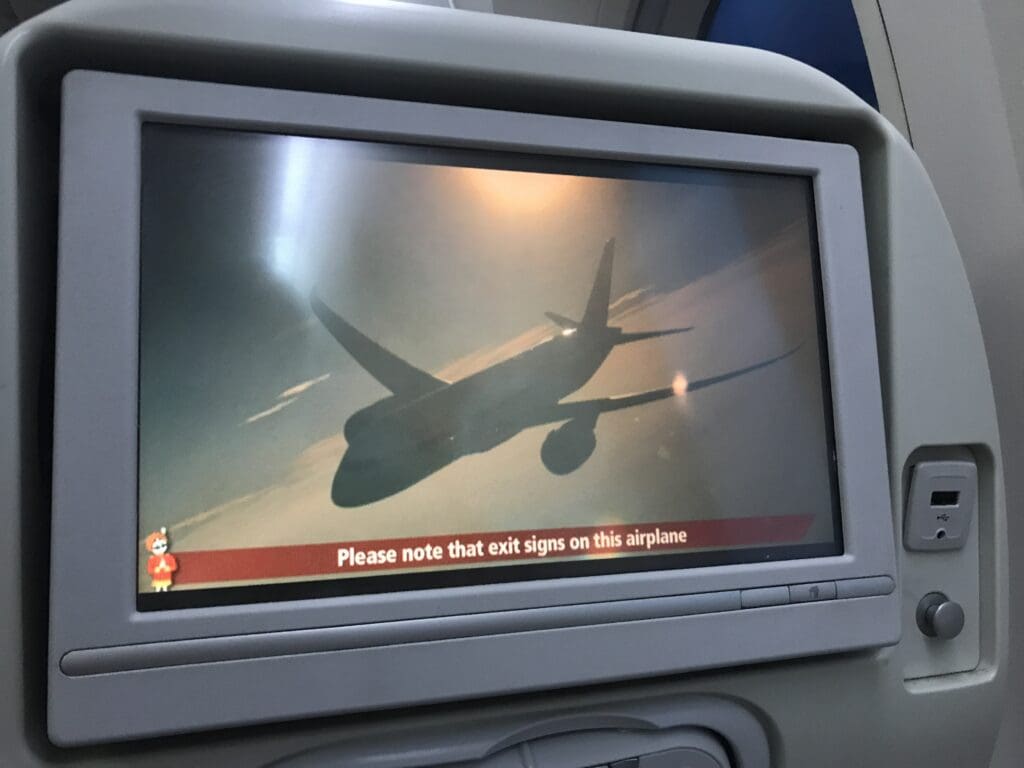
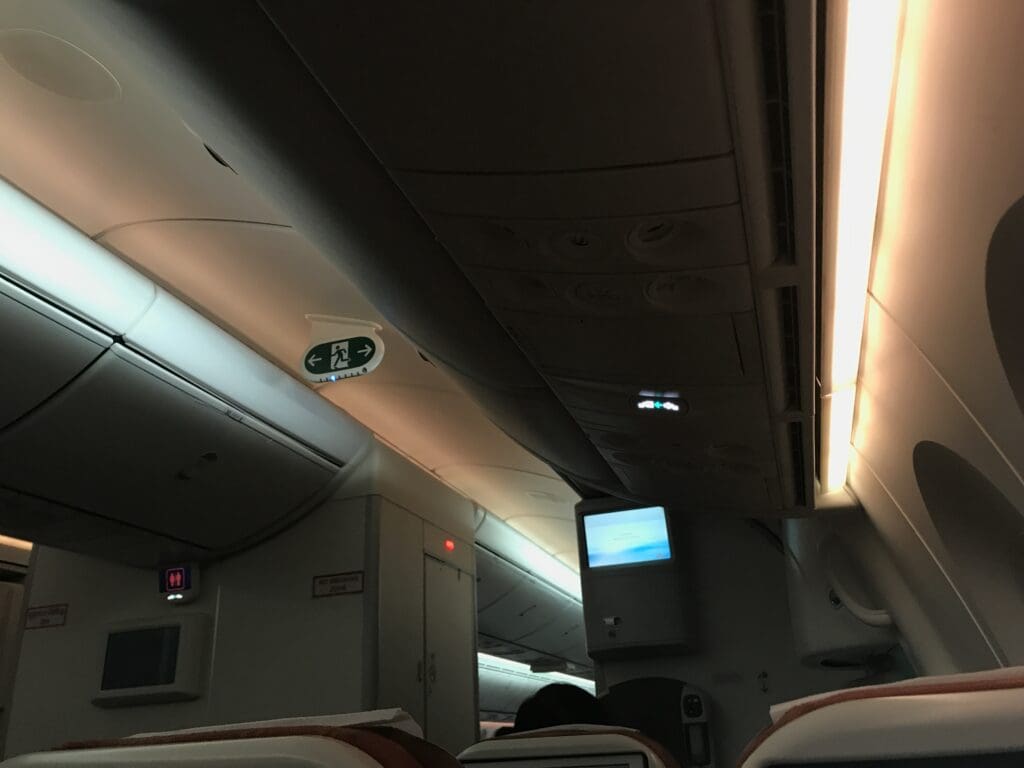
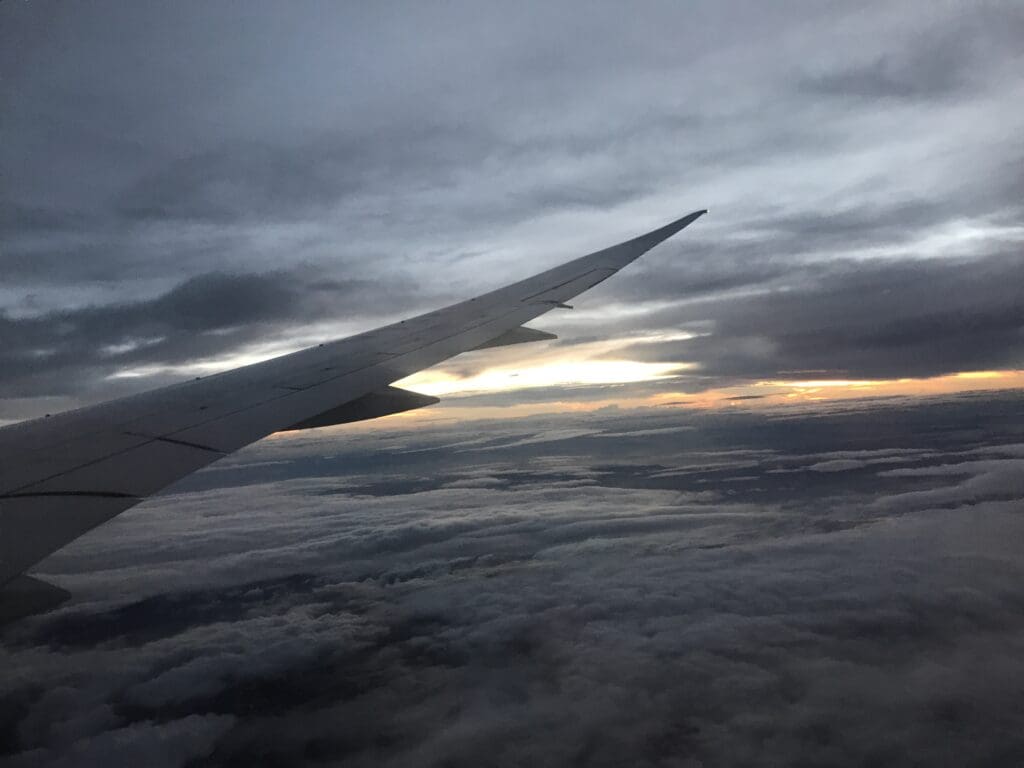
Eventually, the aircraft sank beneath the clouds, revealing the dark South China Sea as well as a host of well-illuminated ships as we neared Hong Kong. At 1940 local time, one of the pilots announced ‘landing in eight minutes’, at which point several crew members made a final check of the cabin before taking their jumpseats. Up ahead, I noticed a good level of engagement between one of the flight attendants and a passenger, with the two spending much of the final stages of the flight engaged in conversation with the flight attendant detailing the best spots to visit in India to one of the Korean Hong Kong bound passengers. After several minutes over the South China Sea, the bright lights of Hong Kong Airport appeared and the landing gear could be heard and felt falling down into position in preparation for our arrival.
At 1949, the aircraft floated over the threshold of Hong Kong’s rain soaked Runway 07L before touching down with an incredibly firm bump which was followed by some equally harsh braking. Once the Dreamliner had slowed to a suitable speed, the aircraft vacated the runway and made its way over to Gate 40. As the aircraft headed over to the gate, the Purser’s voice filled the cabin as they welcomed all passengers to Hong Kong and advised those bound for India to remain on board the aircraft, requesting passengers not to use the aircraft’s toilets whilst on the ground. Several short minutes after touching down, the aircraft slowly pulled into its gate and came to a halt next to an Air Niugini Boeing 767-300ER which would soon be heading to the capital of Papua New Guinea, Port Moresby. Within moments, the two General Electric engines spooled down, and, with the jetbridge soon connected, it wasn’t long until disembarking commenced.
As I had expected, around 60% of the flight’s passengers seemed to remain onboard, whilst the majority of Korean passengers disembarked in Hong Kong. Making my way through the cabin, I trundled through the Dreamliner’s forward Economy cabin before reaching the small Business Class section. Despite being India’s national carrier, the latter was somewhat basic in its design, consisting of eighteen privacy-lacking Safran Aura Lite seats in a 2-2-2 configuration. Turning to the crew, rounding off what had been a generally very good experience in terms of customer service, I received a warm and friendly farewell from each flight attendant that I passed on my way to the front of the aircraft. Soon, I received a final smiley farewell from the Purser before I stepped onto the jetbridge. Once off the aircraft, I was almost immediately required to show my boarding pass and passport, presumably to ensure that I had not left the aircraft in Hong Kong by mistake.
Despite the quick arrival and disembarkation, a long walk and a train ride was required to reach the airport’s large immigration hall. Seeing as immigration forms had not been distributed onboard, once there my first task was to fill out one of these forms before I made my way to one of the immigration desks. Fortunately, with virtually all desks open and no queues, entering Hong Kong was a quick and pleasant experience and with no suitcases to collect, once through I was able to make it landside in no time where I headed to the station in order to catch the next Kowloon bound train.
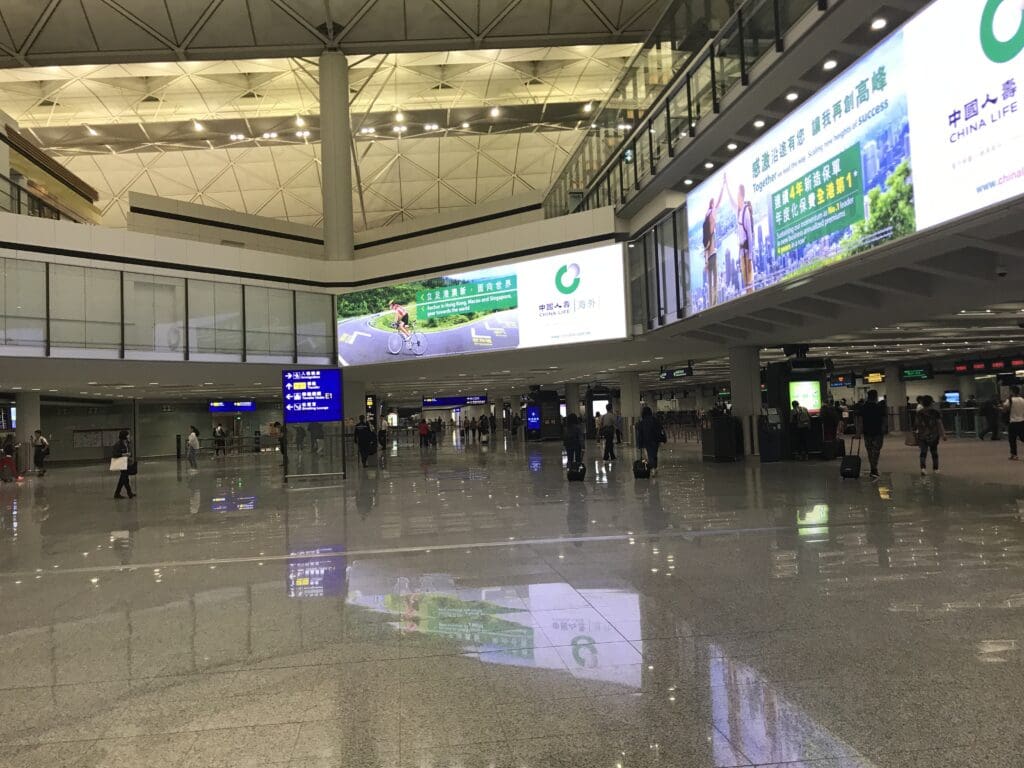
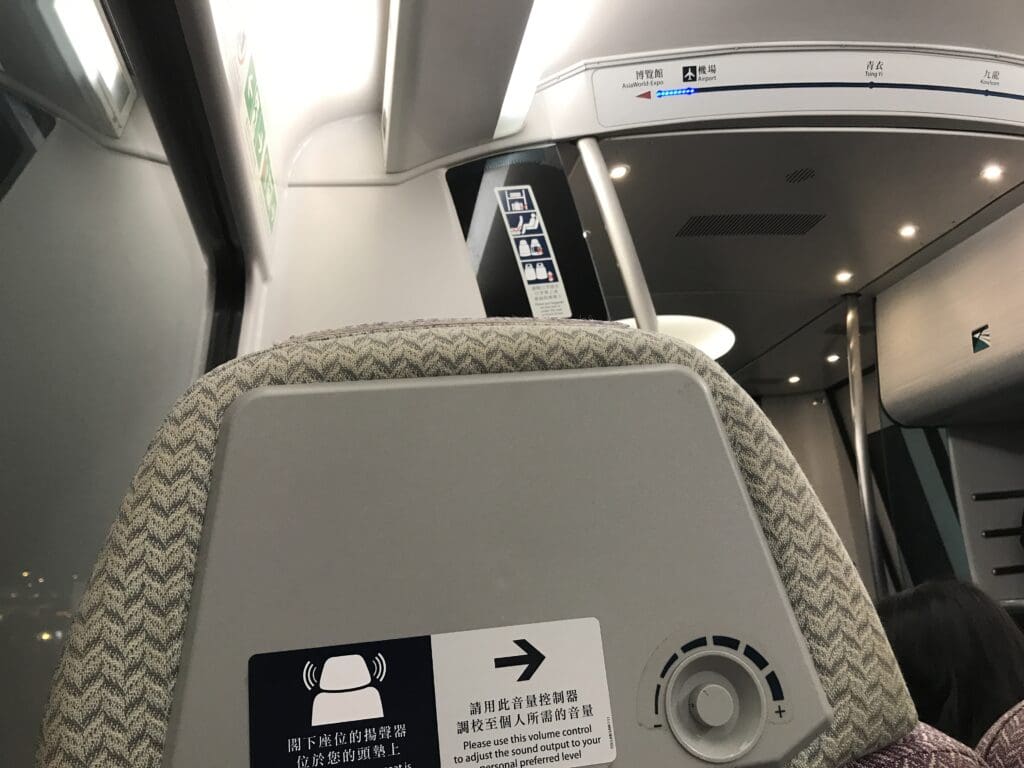
Summary
Having paid relatively little for a last minute ticket on a three hour flight with a legacy carrier, I most certainly got a good deal. Despite the delay and the omnipresent cosmetic damage throughout the cabin, I was reasonably pleased with my Air India experience. Importantly, I found the seat to be spacious and comfortable, the inflight meal was sufficient given the length of the flight and all crew members were polite, friendly and welcoming. With that considered, I would consider flying with Air India again. However, next time I would most certainly hope to find the cabin to be in a much better condition!

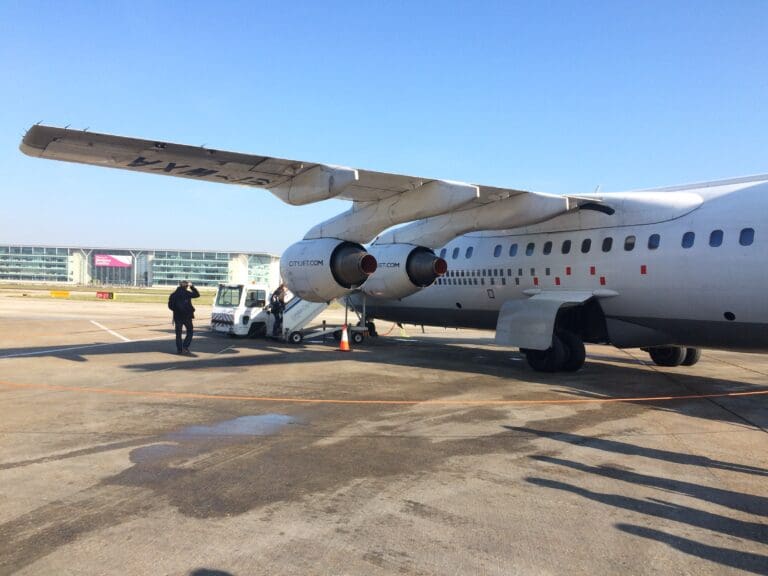
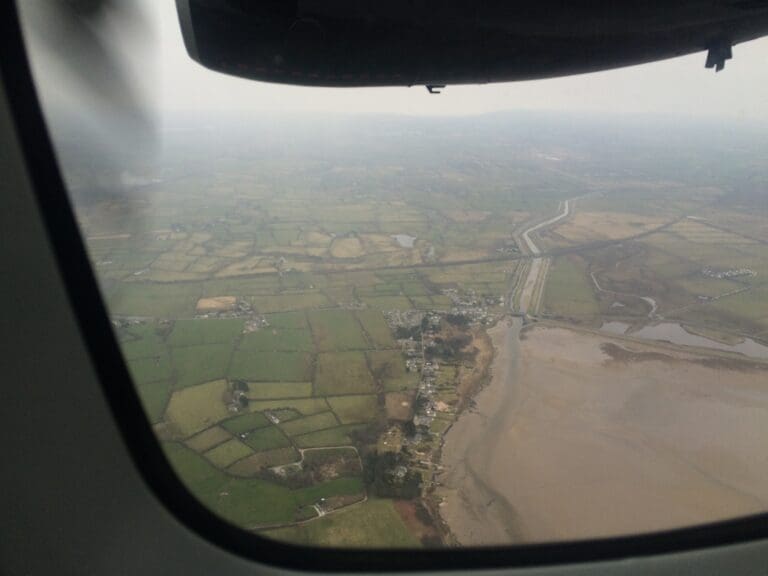
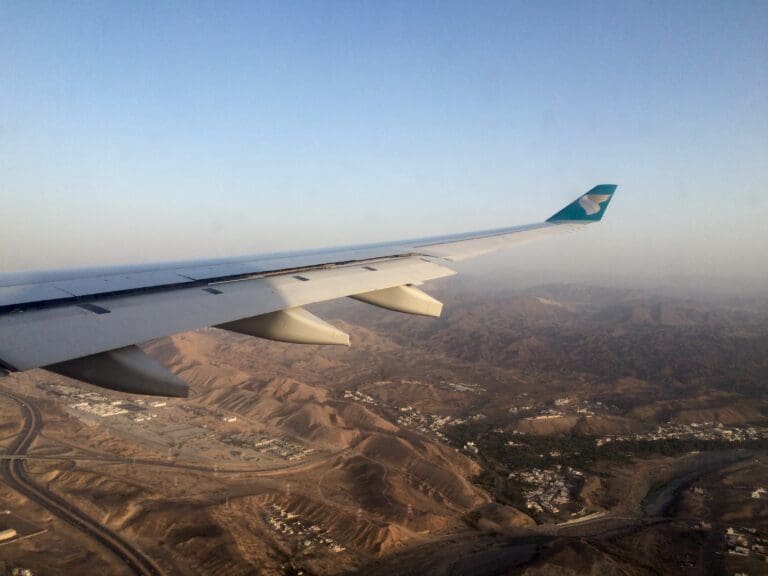
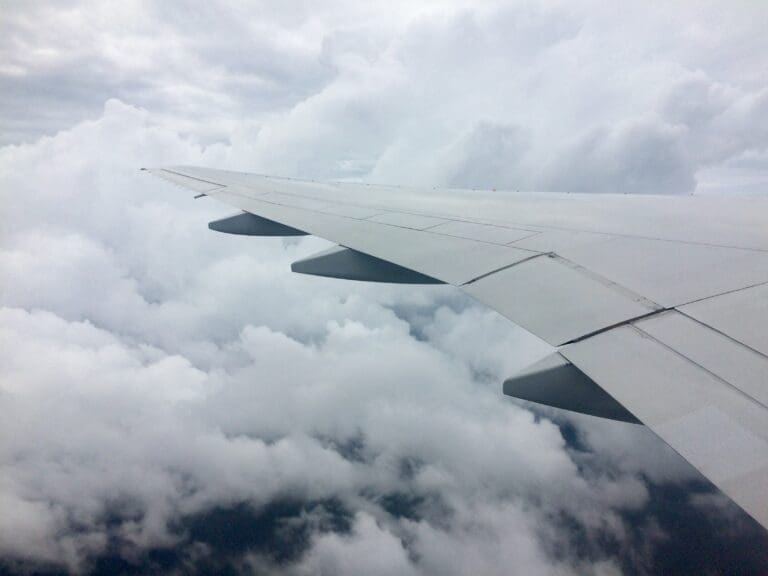
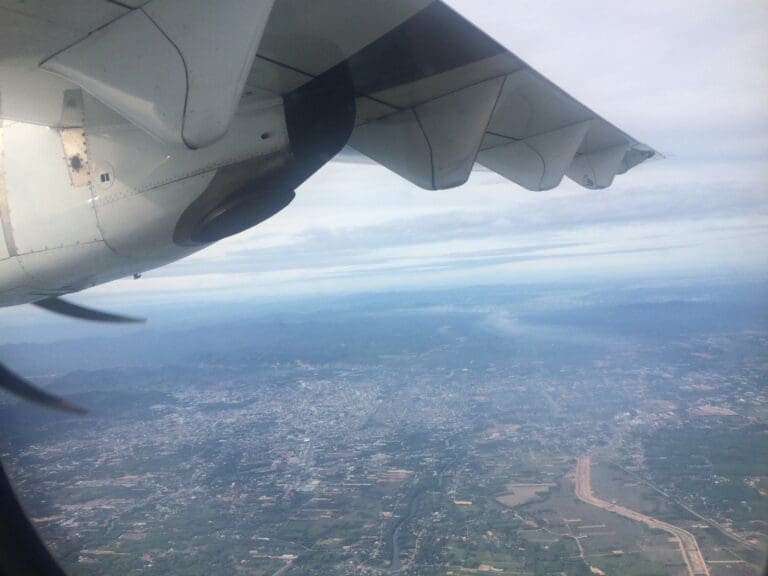
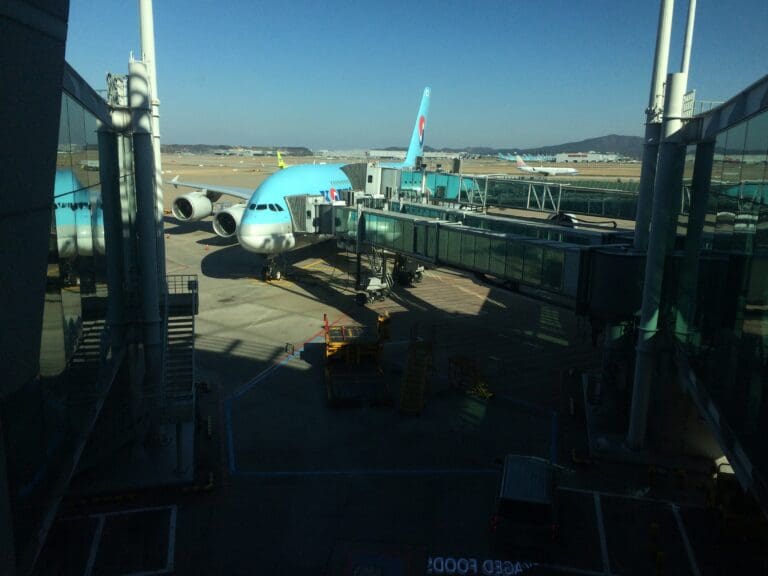
Is that a United 747-400 in one of the photos??
Indeed it is!